Chapter 17: Keeping a Sense of Wonder
Unleash your own Creative Wonders
“The world is but a canvas to our imagination.”-Henry David Thoreau
- Reflecting back on your viewing/reading of the various chapters from Artistic literacies: Creative and imaginative learning in a global era, can you identify some of the images that have inspired and/or interested you most? What was it about these images that captured your imagination and interest? How can you keep a sense of wonder and hope about the planet?
- Create your own collage of 10 landscapes/images that best represent the wonder of nature. You can include your own poems, narrative, and related texts to accompany the images.
- How can art and poetry help heal and transform?
- Read and review one of the books inspired by nature (identified in this section).
- In your view, how disconnected have people become from nature and the natural world? Develop a speech with complementary art/photography that could inspire individuals to “reconnect” with nature.
- Find an artist and poet/writer that you feel best captures the wonder and beauty of nature. Write a biographical profile of the artist/writer/poet. You can also describe the artistic images of the artist.
- Find an artist today that explores themes of nature (poetry, photography, installation, sculpture, beadwork, murals, stories, memoir, etc.) and write a biographical profile of the artist.
- How can art be used to inspire a sense of justice and a critical awareness of the planet today?
- Using art and poetry, create a poster “Imagine a world where….”that best describes your vision of a peaceful world.
- Take a virtual tour of an art gallery (see below for examples) and identify and describe 3-5 paintings that speak to you about existential themes (birth, death, life mysteries, emotions, relationships, nature, and so on).
- How can the power of words combined with visual images shape our sense of place and the the language describing landscapes?
Virtual Teaching and Learning Resources
- Smithsonian American Art Museum, Washington, DC
- Art Gallery of Ontario, Toronto, Ontario
- Brooklyn Museum, New York.
- The British Museum, London, UK.
- The Metropolitan Museum of Art, New York
- Glasgow Life
- The Art Institute of Chicago
- The Cleveland Museum of Art
- Tate
- National Portrait Gallery, London
- National Gallery of Art, London
- Minneapolis Institute of Art
- Museum of Cultural Anthropology, Vancouver, British Columbia
- National Gallery of Finland, Helsinki, Finland
- The Louvre, Paris, France
- The Rijksmuseum, Amsterdam, the Netherlands.
- Vatican museums, Rome, Italy
- Victoria and Albert Museum
- Philadelphia Museum of Art
- Winnipeg Art Gallery & Quamajug Inuit Art Collection
- Other galleries and museums you would like to explore:
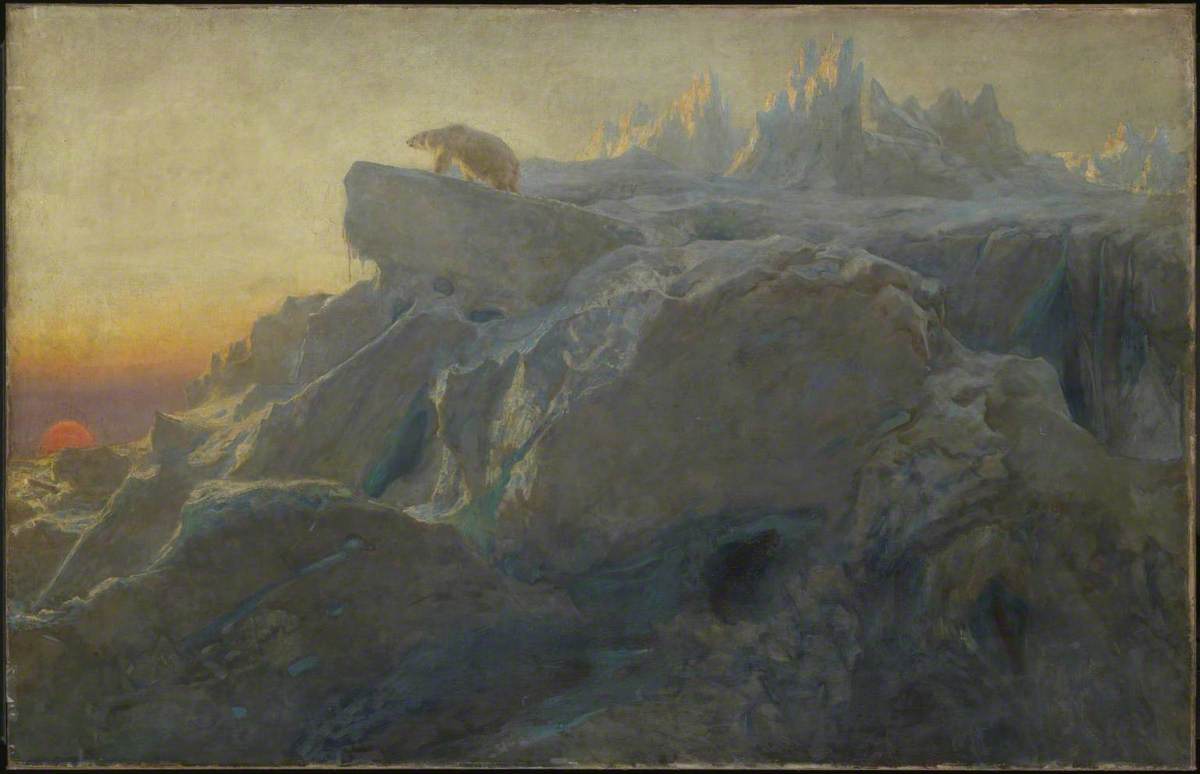
Courtesy: By Briton Rivière – Art UK, Public Domain, https://commons.wikimedia.org/w/index.php?curid=91865474
To read an essay by Diana Donald about Breton Riviere’s painting “Beyond Man’s Footsteps” please open the link here.
The night is darkening round me,
The wild winds coldly blow;
But a tyrant spell has bound me
And I cannot, cannot go.
The giant trees are bending
Their bare boughs weighed with snow.
And the storm is fast descending,
And yet I cannot go.
Clouds beyond clouds above me,
Wastes beyond wastes below;
But nothing drear can move me;
I will not, cannot go.
Literacy and Nature:
“Language is written deeply and richly into our relationships with landscapes and with nature: there are place -names on our maps, and the many names of species, common and rare, with which we share our lives.” -Robert Macfarlane, 2017.
- John Muir Trust: Literacy and Nature
- -The teaching guide above includes many excellent inquiry projects for learners. Valuable books and resources that explore important connections to environmental literacies are included by clicking on the link below.
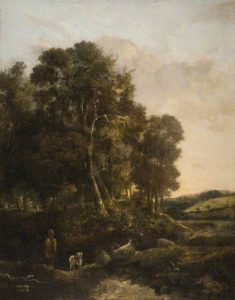
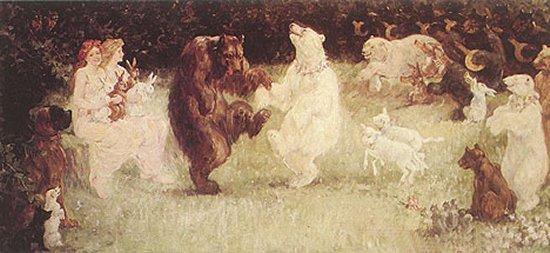
Courtesy: By Frederick Stuart Church – http://1.bp.blogspot.com/_EcfQTb3MMxw/Sd9i4EvnbkI/AAAAAAAAF0Y/0FGCVkN1x2I/s1600-h/Frederick+Stuart+Church.jpg, Public Domain, https://commons.wikimedia.org/w/index.php?curid=6878328
Excerpt from “Spring” by Christina Rossetti
“There is no time like Spring,
When life’s alive in everything,
Before new nestling sing,
Before cleft swallows speed their journey back
Along the trackless track—
God guides their wing,
He spreads their table that they nothing lack,
Before the daisy grows a common flower,
Before the sun has power
To scorch the world up in his noontide hour” (p.20-21).
Landscapes: Real and Imagined
As you view the following landscapes, you can explore some of these questions:
- What is your relationship to nature? What values does your connection to nature represent to you?
- How is the artist portraying the natural scenery that might include mountains, valleys, skies, clouds, trees, rivers, and forests?
- Some of the artists depict animals in their natural habitat. How have the habitats of many animals
- Is the landscape more realistic or imaginary?
- Describe the language that poets use to describe nature. What might be different about the way in which the poets described flowers, landscapes, and animals from earlier centuries (featured in this chapter) and the way in which language is used today to describe elements of nature?
- To what extent was “nature” viewed as something frightening and that needed to be controlled or destroyed? How have different attitudes towards nature impacted ecosystems?
- How do the artists and writers evoke mood and emotion through their work?
- Do any of the landscape images evoke memories that you have of similar places?
- How are colours used to create emotions?
- How do poets use symbolism and imagery to evoke emotion?
- Is the artist portraying a particular season of the year (spring, summer, autumn, winter)?
- How have our geographical landscapes changed over time? What factors contributed to these changes (e.g. erosion, climate change, industrialization, etc.).
- To what extent are natural landscapes threatened today?
- How do we repair the damage and build resilient ecosystems?
- How do we mobilize individuals to take a greater initiative in sustainability?
Excerpt from The Lost Words: A Spell Book by Robert MacFarlane and Jackie Morris (2017). Anansi.
MacFarlane and Morris complement beautiful art images with acrostic poems about plants, flowers, and animals.
To access the learning guide please open the link here.
“Once upon a time, words began to vanish from the language of children. They disappeared so quietly that at first almost no one noticed–fading away like water on stone. The words were those that chidlren used to name the natural world around them: acorn, adder, bluebell, bramble, conker–gone! Fern, heather, kingfisher, otter, raven, willow, wren…all of them gone! The words were becoming lost: no longer vivid in children’s voice, no longer alive in their stories.
You hold in your hands a spellbook for conjuring back these lost words. To read it you will need to seek, find and speak. It deals in things that are missing and things that are hidden, in absences and in appearances. It is told in gold-the gold of the goldfinches that flit through its pages in charms–and it holds not poems but spells of many kind that might just, by the old, strong magic of being spoken aloud, unfold dreams and songs, and summon lost words back into the mouth and the mind’s eye.”-MacFarlane & Morris. 2017, The lost words. Anansi, p. 2.
Links to Resources
The Biodiversity Heritage Library
The Power of Nature: Nature Conservancy
Sustainable art: Environmentally conscious creativity
The Healing Power of Art, Metropolitan Museum of Modern Art
Practical strategies to restore the environment and grandeur of nature
A Guide for Sustainable Schools
Topographical Poetry (loco-descriptive poetry)
Landscapes of Enchantment and Mystery
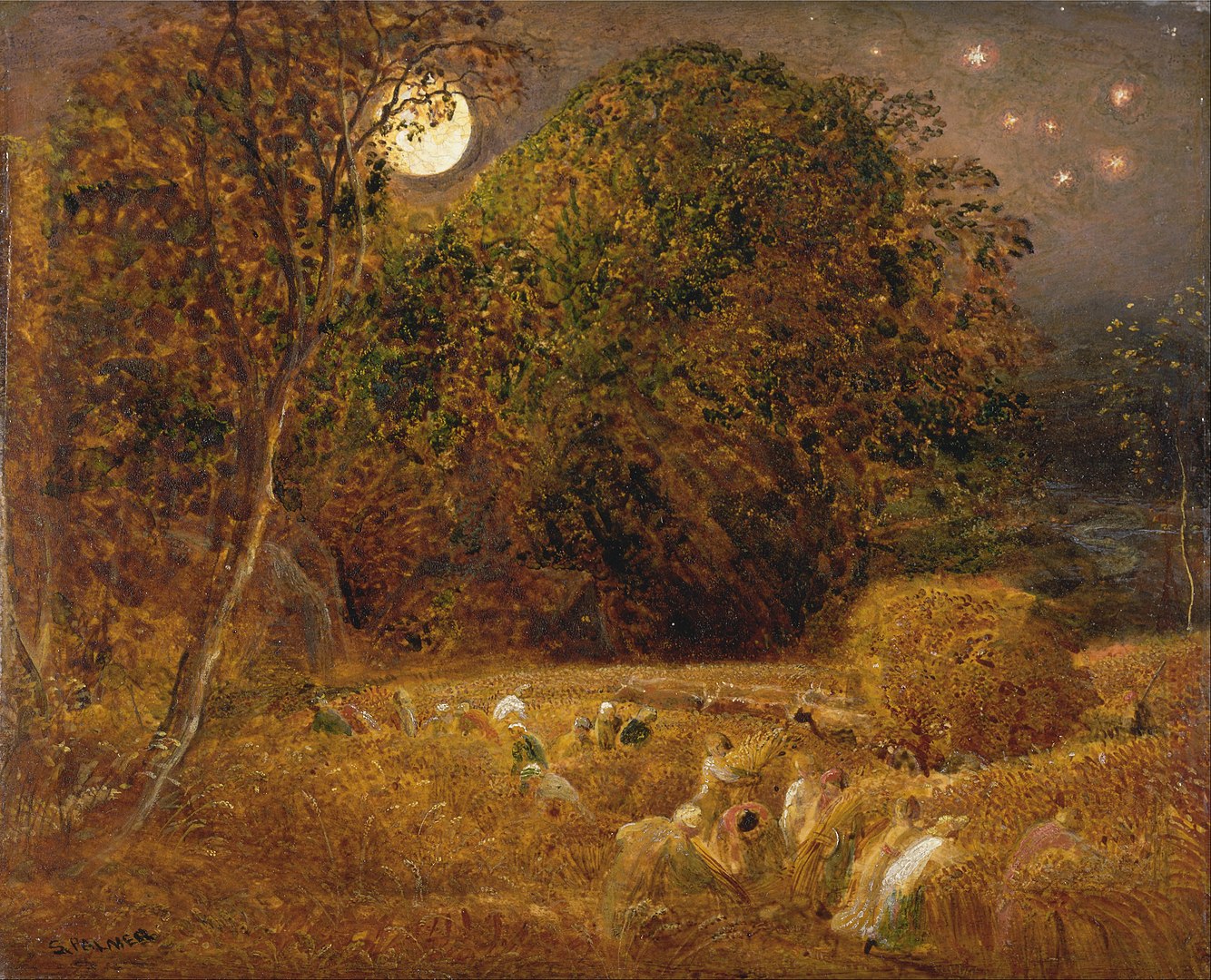
Courtesy: Yale Center for British Art, Paul Mellon Collection. “https://collections.britishart.yale.edu/catalog/tms:414” is licensed under CC0 1.0.
Excerpt from Henry David Thoreau Walden
Solitude ( excerpt from Walden or a Life in the Woods by Henry David Thoreau)
“This is a delicious evening, when the whole body is one sense, and imbibes delight through every pore. I go and come with a strange liberty in Nature, a part of herself. As I walk along the stony shore of the pond in my shirt sleeves, though it is cool as well as cloudy and windy, and I see nothing special to attract me, all the elements are unusually congenial to me. The bullfrogs trump to usher in the night, and the note of the whippoorwill is borne on the rippling wind from over the water. Sympathy with the fluttering alder and poplar leaves almost takes away my breath; yet, like the lake, my serenity is rippled but not ruffled. These small waves raised by the evening wind are as remote from storm as the smooth reflecting surface. Though it is now dark, the wind still blows and roars in the wood, the waves still dash, and some creatures lull the rest with their notes. The repose is never complete. The wildest animals do not repose, but seek their prey now; the fox, and skunk, and rabbit, now roam the fields and woods without fear. They are Nature’s watchmen,—links which connect the days of animated life..” (p. 159)
From “The Ponds” (Walden or A Life in the Woods by Henry David Thoreau)
“When I first paddled a boat on Walden, it was completely surrounded by thick and lofty pine and oak woods, and in some of its coves grape vines had run over the trees next the water and formed bowers under which a boat could pass. The hills which form its shores are so steep, and the woods on them were then so high, that, as you looked down from the west end, it had the appearance of an amphlitheatre for some kind of sylvan spectacle. I have spent many an hour, when I was younger, floating over its surface as the zephyr willed, having paddled my boat to the middle, and lying on my back across the seats, in a summer forenoon, dreaming awake, until I was aroused by the boat touching the sand, and I arose to see what shore my fates had impelled me to; days when idleness was the most attractive and productive industry. Many a forenoon have I stolen away, preferring to spend thus the most valued part of the day; for I was rich, if not in money, in sunny hours and summer days, and spent them lavishly; nor do I regret that I did not waste more of them in the workshop or the teacher’s desk. But since I left those shores the woodchoppers have still further laid them waste, and now for many a year there will be no more rambling through the aisles of the wood, with occasional vistas through which you see the water. My Muse may be excused if she is silent henceforth. How can you expect the birds to sing when their groves are cut down”? (Thoreau, Walden, Arcturus, 2021, p. 159)
Connecting the ideas in Henry David Thoreau’s Walden to Land Based Learning
- Guiding questions for land-based learning include:
- Relevance: How is this learning relevant to the land you are situated in?
- Respect: How is this learning holding reverence towards land and waters?
- Reciprocity: How is this learning upholding the principal to give back what we take from the land?
- What can the water teach us about how we can approach racial justice in schools?
- What can the four seasons teach us about the cycle of life in plants, animals, and humans? (University of British Columbia, Land Based Learning Guides).
From “Night” by William Blake
The sun descending in the west,
The evening star does shine;
The birds are silent in their nest,
And I must seek for mine.
The moon, like a flower
In heaven’s high bower
With silent delight,
Sits and smiles on the night.
From: National Geographic. Book of Nature Poetry. Edited by Patrick Lewis. Washington DC.
“In Lands I Never Saw – They Say” by Emily Dickinson
In lands I never saw — they say
Immortal Alps look down —
Whose Bonnets touch the firmament —
Whose Sandals touch the town —
Meek at whose everlasting feet
A Myriad Daisy play —
Which, Sir, are you and which am I
Upon an August day?
For more of Emily Dickinson’s poems please open the Internet Archive link here. (Little, Brown, & Co. 1930).
Stars, Comets, and Cosmic Phenomena
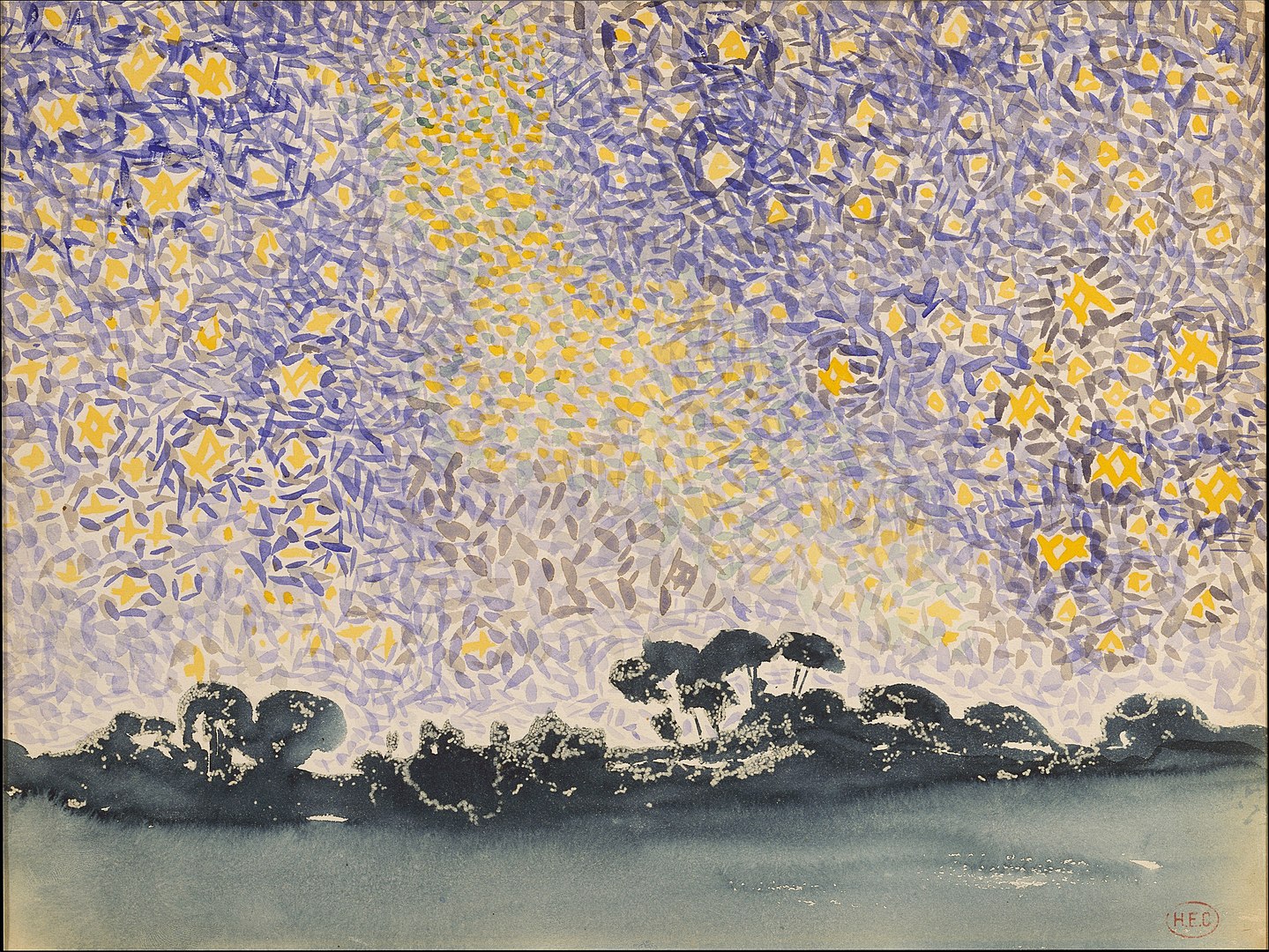
Courtesy: Robert Lehman Collection, 1975. “https://www.metmuseum.org/art/collection/search/459189” is licensed under CC0 1.0.
American Astronomer Edward Singleton Holden (1902) wrote:
“Wonder is the child of knowledge—of partial and imperfect knowledge, to be sure, but still, of knowledge. The very first step in Science is to make an inventory of external Nature (and by and by of the faculties of the mind that thinks). The second step is to catalogue similar appearances together. It is a much higher flight to seek the causes of likenesses thus discovered… Suppose that, at some future day, all physical and mechanical laws should be found to be direct consequences of a single majestic law, just as all the motions of the planets are (but—are they?) the direct results of the single law of gravitation. Gravitation will, probably, soon be explained in terms of some remoter cause, but the reason of that single and ultimate law of the universe which we have imagined would still remain unknown. Human knowledge will always have limits, and beyond those limits there will always be room for mystery and wonder. A complete and exhaustive explanation of the world is inconceivable, so long as human powers and capacities remain at all as they now are..” (Singleton Holden, 1902, in Young Folks Library: Wonders of the Earth, Sea, and Sky Hall & Locke Co., p.2).
Please open the link here to learn more about the American astronomer Edward Singleton Holden 1846-1914)
“Comets” from Marvels of the Heavens by Camille Flamarion, 1902, in Young Folks’ Library:
Wonders of Earth, Sea and Sky edited by Edward Singleton Holden, Hall & Locke Co., p. 109.
“The history of a comet would be an instructive episode of the great history of the
heavens. In it could be brought together the description of the progressive movement of
human thought, as well as the astronomical theory of these extraordinary bodies. Let us
take, for example, one of the most memorable and best-known comets, and give an
outline of its successive passages near the Earth. Like the planetary worlds, Comets
belong to the solar system, and are subject to the rule of the Star King. It is the universal
law of gravitation which guides their path; solar attraction governs them, as it governs the
movement of the planets and the small satellites. The chief point of difference between
them and the planets is, that their orbits are very elongated; and, instead of being nearly
circular, they take the elliptical form. In consequence of the nature of these orbits, the
same comet may approach very near the Sun, and afterwards travel from it to immense
distances. Thus, the period of the Comet of 1680 has been estimated at three thousand
years. It approaches the Sun, so as to be nearer to it than our Moon is to us, whilst it
recedes to a distance 853 times greater than the distance of the Earth from the Sun. On
the 17th of December, 1680, it was at its perihelion—that is, at its greatest proximity to
the Sun; it is now continuing its path beyond the Neptunian orbit. Its velocity varies
according to its distance from the solar body. At its perihelion it travels thousands of
leagues per minute; at its aphelion it does not pass over more than a few yards. Its
proximity to the Sun in its passage near that body caused Newton to think that it received
a heat twenty-eight thousand times greater than that we experience at the summer [pg 254]
solstice; and that this heat being two thousand times greater than that of red-hot iron, an
iron globe of the same dimensions would be fifty thousand years entirely losing its heat.
Newton added that in the end comets will approach so near the Sun that they will not be
able to escape the preponderance of its attraction, and that they will fall one after the
other into this brilliant body, thus keeping up the heat which it perpetually pours out into
space.” (Flamarion, 1902, p. 109).
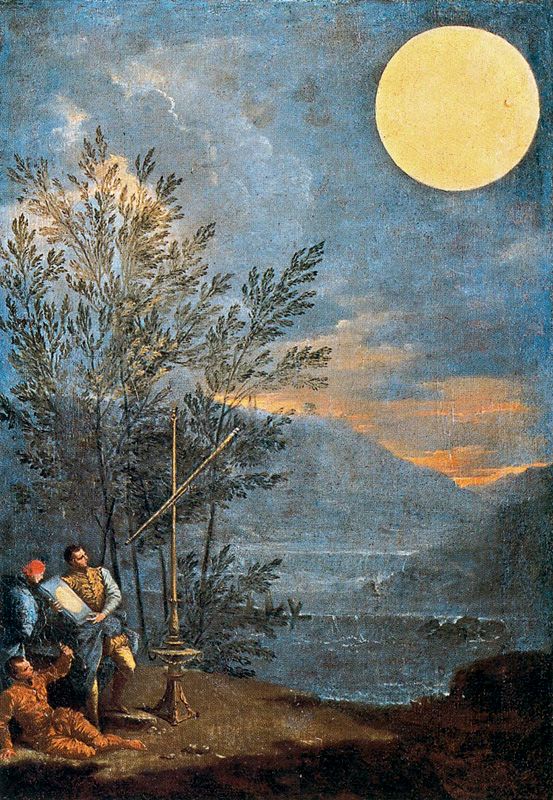
Courtesy: By Donato Creti – Pinacoteca Vaticana, Public Domain, https://commons.wikimedia.org/w/index.php?curid=48553211
“Bright star, would I were stedfast as thou art” by John Keats
Bright star! would I were steadfast as thou art—
Not in lone splendour hung aloft the night,
And watching, with eternal lids apart,
Like Nature’s patient sleepless Eremite,
The moving waters at their priestlike task
Of pure ablution round earth’s human shores,
Or gazing on the new soft fallen mask
Of snow upon the mountains and the moors—
No—yet still steadfast, still unchangeable,
Pillow’d upon my fair love’s ripening breast,
To feel for ever its soft fall and swell,
Awake for ever in a sweet unrest,
Still, still to hear her tender-taken breath,
And so live ever—or else swoon to death.
“She dwelt among the untrodden ways” by William Wordsworth
She dwelt among the untrodden ways
Beside the springs of Dove,
A Maid whom there were none to praise
And very few to love:
A violet by a mossy stone
Half hidden from the eye!
—Fair as a star, when only one
Is shining in the sky.
She lived unknown, and few could know
When Lucy ceased to be;
But she is in her grave, and, oh,
The difference to me!
(Retrieved October 20, 2022 Internet Archive , The Poetical Works of William Wordsworth. Edward Moxon, Publisher, 1847.)
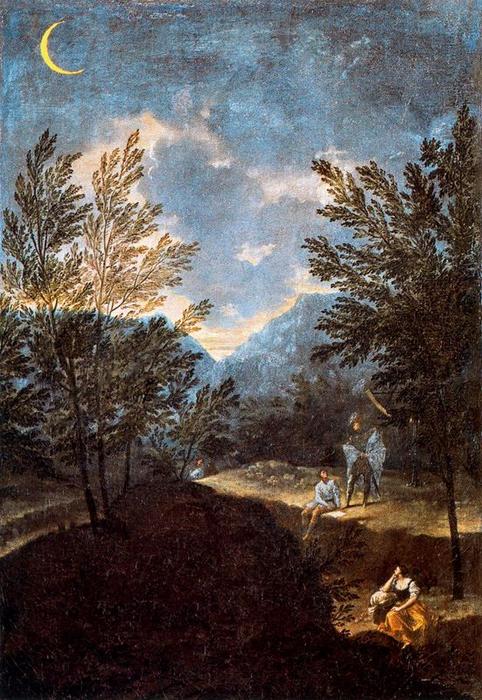
Courtesy: By Donato Creti – Pinacoteca Vaticana, Public Domain, https://commons.wikimedia.org/w/index.php?curid=48553212
“Moonlight Night” by Rainer Maria Rilke
South-German night! the ripe moon hangs above
Weaving enchantment o’er the shadowy lea.
From the old tower the hours fall heavily
Into the dark as though into the sea—
A rustle, a call of night-watch in the grove,
Then for a while void silence fills the air;
And then a violin (from God knows where)
Awakes and slowly sings: Oh Love … Oh Love …
(Poems by Rainer Maria Rilke (Translated by Jesse Lemont). Tobias A. Wright, 1918.)
“O Sun Of Real Peace” by Walt Whitman
O SUN of real peace! O hastening light!
O free and extatic! O what I here, preparing, warble for!
O the sun of the world will ascend, dazzling, and take his height—
and you too, O my Ideal, will surely ascend!
O so amazing and broad—up there resplendent, darting and burning!
O vision prophetic, stagger’d with weight of light! with pouring
glories!
O lips of my soul, already becoming powerless!
O ample and grand Presidentiads! Now the war, the war is over!
New history! new heroes! I project you!
Visions of poets! only you really last! sweep on! sweep on!
O heights too swift and dizzy yet!
O purged and luminous! you threaten me more than I can stand!
(I must not venture—the ground under my feet menaces me—it will not
support me:
O future too immense,)—O present, I return, while yet I may, to you.
“To the Evening Star” by William Blake
Thou fair-haired angel of the evening,
Now, whilst the sun rests on the mountains, light
Thy bright torch of love; thy radiant crown
Put on, and smile upon our evening bed!
Smile on our loves, and while thou drawest the
Blue curtains of the sky, scatter thy silver dew
On every flower that shuts its sweet eyes
In timely sleep. Let thy west wing sleep on
The lake; speak silence with thy glimmering eyes,
And wash the dusk with silver. Soon, full soon,
Dost thou withdraw; then the wolf rages wide,
And the lion glares through the dun forest.
The fleeces of our flocks are covered with
Thy sacred dew; protect with them with thine influence.
“The Comet -1858” (Excerpt) by Charles Sangster
Erratic Soul of some great Purpose, doomed
To track the wild illimitable space,
Till sure propitiation has been made
For the divine commission unperformed!
What was thy crime? Ahasuerus’ curse
Were not more stern on earth than thine in Heaven!
Art thou the Spirit of some Angel World,
For grave rebellion banished from thy peers,
Compelled to watch the calm, immortal stars,
Circling in rapture the celestial void,
While the avenger follows in thy train
To spur thee on to wretchedness eternity?
Or one of nature’s wildest fantasies,
From which she flies in terror so profound,
And with such whirl of torment in her breast,
That mighty earthquakes yearn where’er she treads;
While War makes red its terrible right hand,
And Famine stalks abroad all lean and wan?
To us thou art as exquisitely fair
As the ideal visions of the seer,
Or gentlest fancy that e’er floated down
Imagination’s bright, unruffled stream,
Wedding the thought that was too deep for words
To the low breathings of inspired song.
“Sonnet 14” by William Shakespeare
Not from the stars do I my judgement pluck;
And yet methinks I have Astronomy,
But not to tell of good or evil luck,
Of plagues, of dearths, or seasons’ quality;
Nor can I fortune to brief minutes tell,
Pointing to each his thunder, rain and wind,
Or say with princes if it shall go well
By oft predict that I in heaven find …
“The Stars are Mansions Built by Nature’s Hand” by William Wordsworth
The stars are mansions built by Nature’s hand,
And, haply, there the spirits of the blest
Dwell, clothed in radiance, their immortal vest;
Huge Ocean shows, within his yellow strand,
A habitation marvellously planned,
For life to occupy in love and rest …
“Night” by William Blake
The sun descending in the west,
The evening star does shine;
The birds are silent in their nest
And I must seek for mine.
The Moon like a flower,
In heaven’s high bower
With silent delight
Sits and smiles on the night….
From: Songs of Innocence and Experience (p. 25). Dover.
“Paradise: In A Dream” by Christina Rossetti
Once in a dream I saw the flowers
That bud and bloom in Paradise;
More fair they are than waking eyes
Have seen in all this world of ours.
And faint the perfume-bearing rose,
And faint the lily on its stem,
And faint the perfect violet
Compared with them.
I heard the songs of Paradise:
Each bird sat singing in his place;
A tender song so full of grace
It soared like incense to the skies.
Each bird sat singing to his mate
Soft cooing notes among the trees:
The nightingale herself were cold
To such as these.
I saw the fourfold River flow,
And deep it was, with golden sand;
It flowed between a mossy land
With murmured music grave and low.
It hath refreshment for all thirst,
For fainting spirits strength and rest:
Earth holds not such a draught as this
From east to west.
The Tree of Life stood budding there,
Abundant with its twelvefold fruits;
Eternal sap sustains its roots,
Its shadowing branches fill the air.
Its leaves are healing for the world,
Its fruit the hungry world can feed,
Sweeter than honey to the taste
And balm indeed.
I saw the gate called Beautiful;
And looked, but scarce could look, within;
I saw the golden streets begin,
And outskirts of the glassy pool.
Oh harps, oh crowns of plenteous stars,
Oh green palm-branches many-leaved?
Eye hath not seen, nor ear hath heard,
Nor heart conceived.
I hope to see these things again,
But not as once in dreams by night;
To see them with my very sight,
And touch, and handle, and attain:
To have all Heaven beneath my feet
For narrow way that once they trod;
To have my part with all the saints,
And with my God.
Collected Poems of Christina Rossetti (pp.62-63)
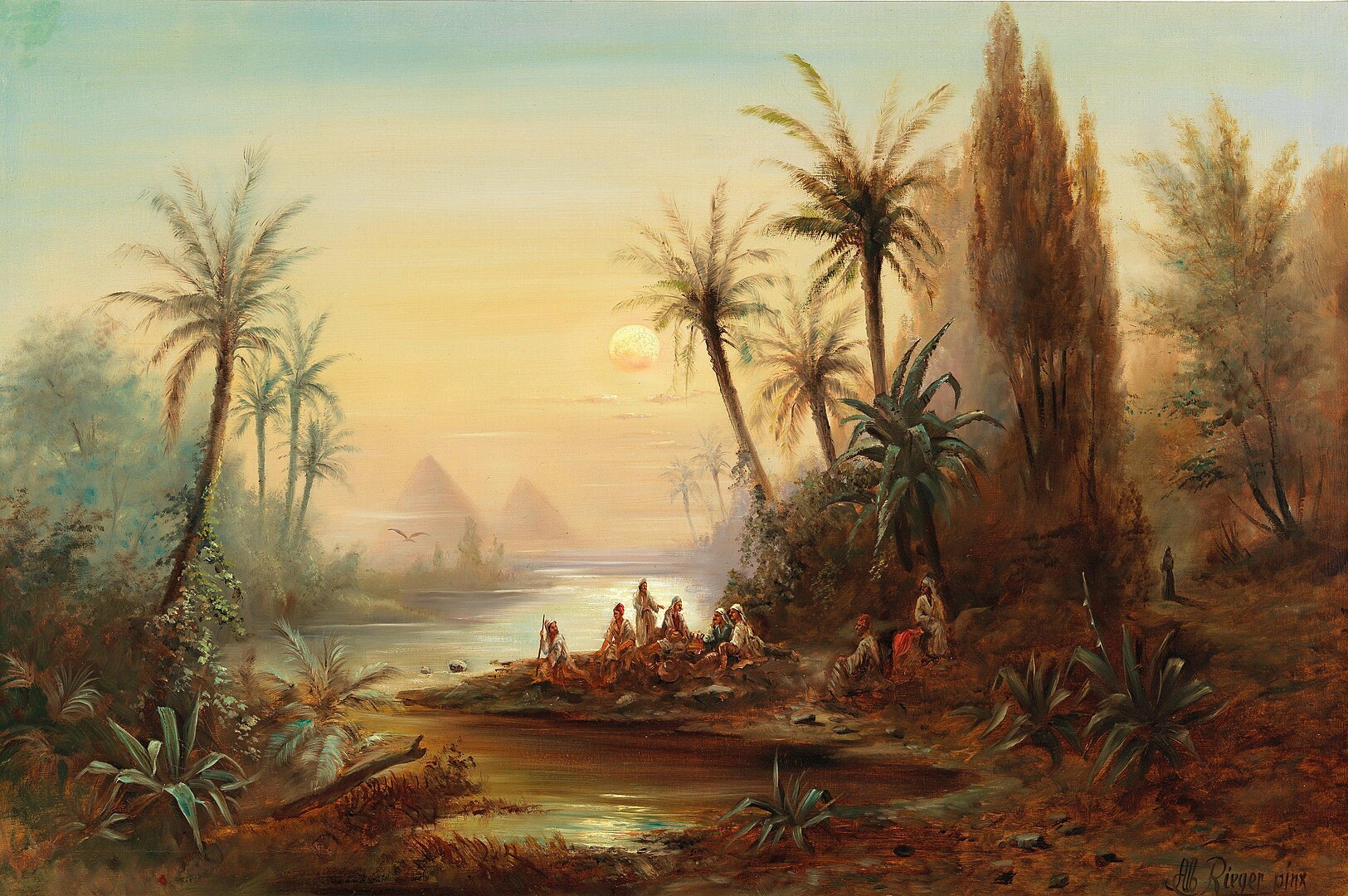
Courtesy: By Albert Rieger – Dorotheum: Info about artwork, Public Domain, https://commons.wikimedia.org/w/index.php?curid=76674730
Excerpt from “The Valley of the Nile” by Thomas Moore
Far as the sight can reach, beneath as clear
And blue a heaven as ever blest this sphere,
Gardens and pillared streets and porphyry domes
And high-built temples, fit to be the homes
Of mighty gods, and pyramids whose hour
Outlasts all time, above the waters tower!
Then, too, the scenes of pomp and joy that make
One theatre of this vast peopled lake,
Where all that Love, Religion, Commerce gives
Of life and motion, ever moves and lives,
Here, up in the steps of temples, from the wave
Ascending, in procession slow and grave,
Priests in white garments go, with sacred wands
And silver cymbals gleaming in their hands:
While there, rich barks—fresh from those sunny tracts
Far off, beyond the sounding cataracts—
Glide with their precious lading to the sea,
Plumes of bright birds, rhinoceros’ ivory,
Gems from the isle of Meroë, and those grains
Of gold, washed down by Abyssinian rains.
“The Land of Dreams” by William Blake
Awake, awake my little Boy!
Thou wast thy Mother’s only joy:
Why dost thou weep in thy gentle sleep?
Awake! thy Father does thee keep.
“O, what land is the Land of Dreams?
What are its mountains, and what are its streams?
O Father, I saw my Mother there,
Among the lillies by waters fair.
Among the lambs clothed in white
She walked with her Thomas in sweet delight.
I wept for joy, like a dove I mourn—
O when shall I return again?”
Dear child, I also by pleasant streams
Have wandered all night in the Land of Dreams;
But though calm and warm the waters wide,
I could not get to the other side.
“Father, O Father, what do we here,
In this land of unbelief and fear?
The Land of Dreams is better far
Above the light of the Morning Star.”
The Complete Poetry & Prose of William Blake Paperback – April 16, 1982 by William Blake (Author), David V. Erdman (Editor), Harold Bloom (Author), William Golding (Author). University of California. Internet Archive.
Individuals in Landscapes
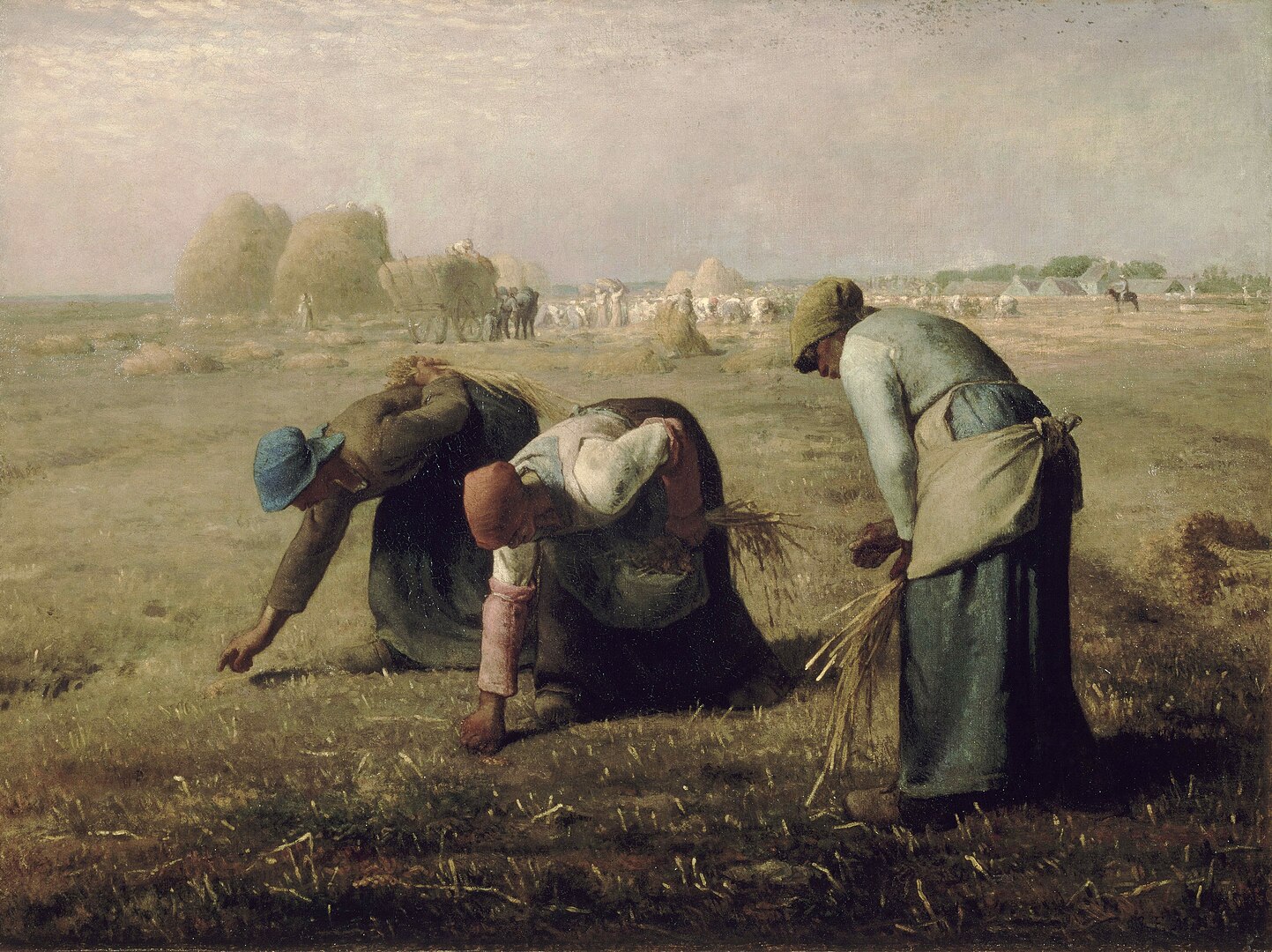
Courtesy: By Jean-François Millet – CgHjAgexUzNOOw — Google Arts & Culture, Public Domain, https://commons.wikimedia.org/w/index.php?curid=20111149
“Reapers” by Mathilde Blind
Sun-Tanned men and women, toiling there together;
Seven I count in all, in yon field of wheat,
Where the rich ripe ears in the harvest weather
Glow an orange gold through the sweltering heat.
Busy life is still, sunk in brooding leisure:
Birds have hushed their singing in the hushed tree tops;
Not a single cloud mars the flawless azure;
Not a shadow moves o’er the moveless crops;
In the grassy shallows, that no breath is creasing,
Chestnut-coloured cows in the rushes dank
Stand like cows of bronze, save when they flick the teasing
Flies with switch of tail from each quivering flank.
Nature takes a rest-even her bees are sleeping,
And the silent wood seems a church that’s shut;
But these human creatures cease not from their reaping
While the corn stands high, waiting to be cut.
© by owner. provided at no charge for educational purpose
*Mathilde Blind (German-British) was one of the great 19th century women poets. Her work has increasingly become important today. She was a strong supporter of social justice movements that included women’s rights and the freedom and autonomy of struggling nationalities.”
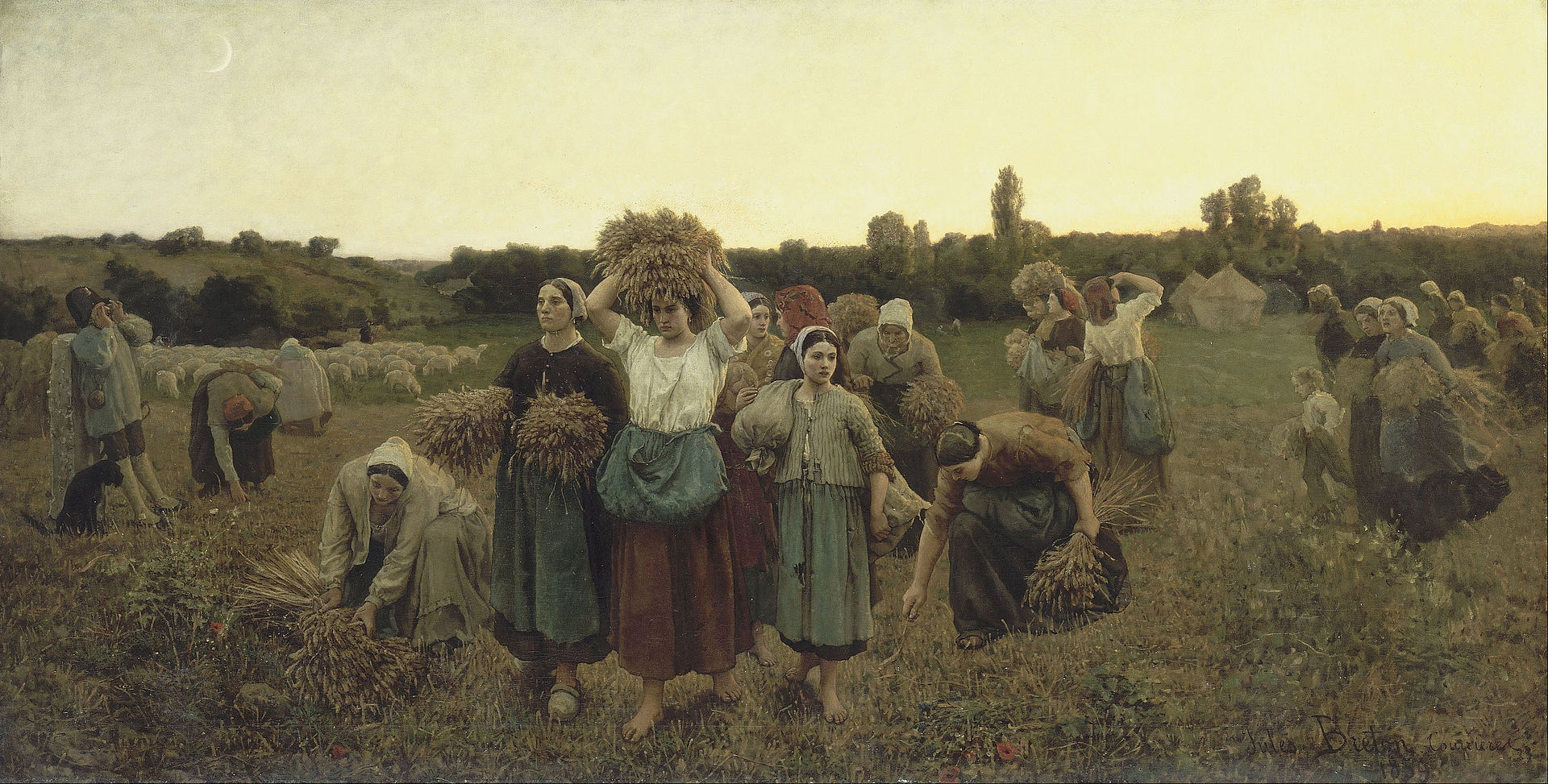
Courtesy: By Jules Breton – 0QGqDnTkuwx5Fg at Google Cultural Institute maximum zoom level, Public Domain, https://commons.wikimedia.org/w/index.php?curid=21880347
“With Calling in the Gleaners, Jules Breton represented an ordinary scene of peasant life in Courrières, his native village in Artois. He did not show the gleaners at work, as Jean-François Millet had done two years before, but leaving the fields. Several elements in the painting situate the scene at dusk: the thin crescent moon on the upper left, the presence of the rural policeman leaning against a milestone with his hands around his mouth like a speaking trumpet as he calls in the gleaners, but above all the sunset behind the trees which gives the painting the warm golden glow of late afternoon. Despite the presence of a few more realistic details such as the women’s threadbare, ragged garments or bare feet, the painter has completely idealised the scene. The noble attitudes, the haughty bearing of the peasant women, and the frieze-like arrangement of the figures confer an air of nobility and poetry.
In turning away from the representation of the miserable plight of the labouring class of his early years to paint an idyllic, picturesque vision of the working world, Jules Breton pleased the critics and the public. This painting was much admired at the Salon of 1859 and even caught the eye of the Empress Eugenie. The Empress arranged for its purchase on Napoleon III’s Civil List. Initially exhibited at the Château de Saint Cloud, it was given by the Emperor to the Musée du Luxembourg in 1862, known at the time as the Musée des Artistes Vivants.” (Art Notes, Musee D’Orsay, Paris, France)
“The Sower” by Charles G.D. Roberts
A brown sad-coloured hillside, where the soil,
Fresh from the frequent harrow, deep and fine,
Lies bare; no break in the remote sky-line,
Save where a flock of pigeons streams aloft,
Startled from feed in some low-lying croft,
Or far-off spires with yellow of sunset shine;
And here the Sower, unwittingly divine,
Exerts the silent forethought of his toil.
Alone he treads the glebe, his measured stride
Dumb in the yielding soil; and tho’ small joy
Dwell in his heavy face, as spreads the blind
Pale grain from his dispensing palm aside,
This plodding churl grows great in his employ;—
Godlike, he makes provision for mankind.
© by owner. provided at no charge for educational purpose
“The Harvest Moon” by Henry Wadsworth Longfellow
It is the Harvest Moon! On gilded vanes
And roofs of villages, on woodland crests
And their aerial neighborhoods of nests
Deserted, on the curtained window-panes
Of rooms where children sleep, on country lanes
And harvest-fields, its mystic splendor rests!
Gone are the birds that were our summer guests,
With the last sheaves return the laboring wains!
All things are symbols: the external shows
Of Nature have their image in the mind,
As flowers and fruits and falling of the leaves;
The song-birds leave us at the summer’s close,
Only the empty nests are left behind,
And pipings of the quail among the sheaves.
“Daybreak” by John Fletcher (From: “The Faithful Shepherdess”)
See, the day begins to break,
And the light shoots like a streak
Of subtle fire; the wind blows cold
Whilst the morning doth unfold;
Now the birds begin to rouse,
And the squirrel from the boughts
Leaps to get him nuts and fruit:
The early lark, that erst was mute,
Carols to the rising day
Many a note and many a lay.
Source: Carr, S. (2015). (Favourite Poems of the Countryside, p. 71.) Batsford.
“Summer” by John Clare
Nature Text Excerpts from Walden by Henry David Thoreau
“All intelligences wake in the morning” -The Veda
“Every morning was a cheerful invitation to make my life of equal simplicity, and I may say innocence, with Nature herself….We must learn to reawaken and keep ourselves awake, not by mechanical aids, but by an infinite expectation of the dawn, which does not forsake us in our soundest sleep….
I went to the woods because I wished to live deliberately, to front only the essential facts of life, and see if I could not learn what it had to teach, and not, when I came to die, discover that I had not lived. I did not wish to live what was not life, living is so dear, nor did I wish to practise resignation, unless it was quite necessary. I wanted to live deep and suck out all the marrow of life, to live so sturdily and Spartan-like as to put to rout all that was not life, to cut a broad swath and shave close, to drive life into a corner and not reduce it to the lowest terms, and, if it proved to be mean, why then to get the whole and genuine meanness of it, and publish its meanness to the whole; or if it were submlime, to know it by experience and be able to give a true account of it in my next excursion” (Thoreau, Walden, Arcturus Pub., 2021, p. 78-79).
“The Forest Pool” by Mathilde Blind
LOST amid gloom and solitude,
A pool lies hidden in the wood,
A pool the autumn rain has made
Where flowers with their fair shadows played.
Bare as a beggar’s board, the trees
Stand in the water to their knees;
The birds are mute, but far away
I hear a bloodhound’s sullen bay.
Blue-eyed forget-me-nots that shook,
Kissed by a little laughing brook,
Kissed too by you with lips so red,
Float in the water drowned and dead.
And dead and drowned ‘mid leaves that rot,
Our angel-eyed Forget-me-not,
The love of unforgotten years,
Floats corpse-like in a pool of tears
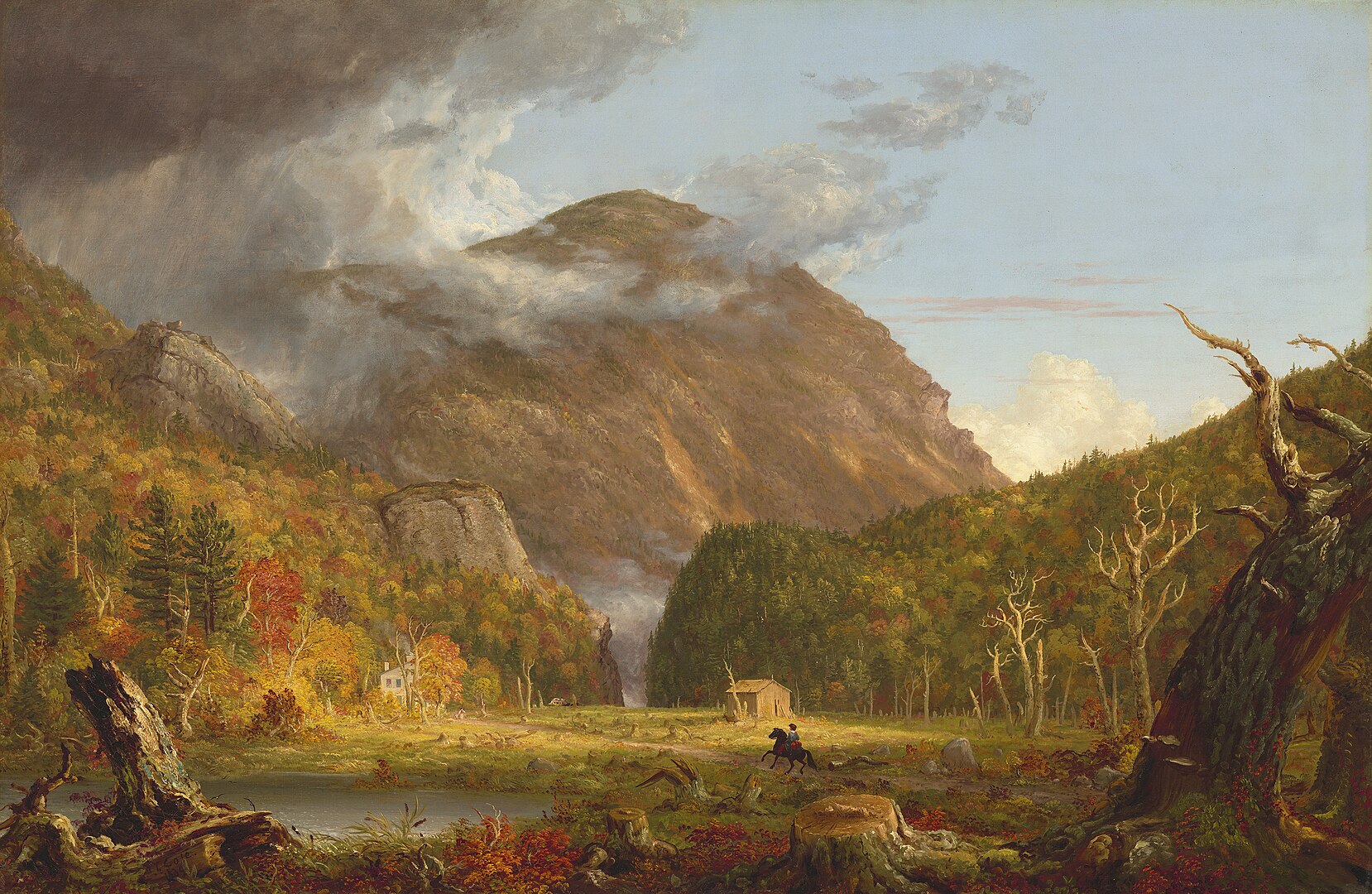
Courtesy: Andrew W. Mellon Fund. “https://www.nga.gov/collection/art-object-page.50727.html” is licensed under CC0 1.0.
“To Winter” by William Blake
O Winter! bar thine adamantine doors:
The north is thine; there hast thou built thy dark
Deep-founded habitation. Shake not thy roofs
Nor bend thy pillars with thine iron car.
He hears me not, but o’er the yawning deep
Rides heavy; his storms are unchain’d, sheathed
In ribbed steel; I dare not lift mine eyes;
For he hath rear’d his scepter o’er the world.
Lo! now the direful monster, whose skin clings
To his strong bones, strides o’er the groaning rocks:
He withers all in silence, and in his hand
Unclothes the earth, and freezes up frail life.
He takes his seat upon the cliffs, the mariner
Cries in vain. Poor little wretch! that deal’st
With storms; till heaven smiles, and the monster
Is driven yelling to his caves beneath Mount Hecla.
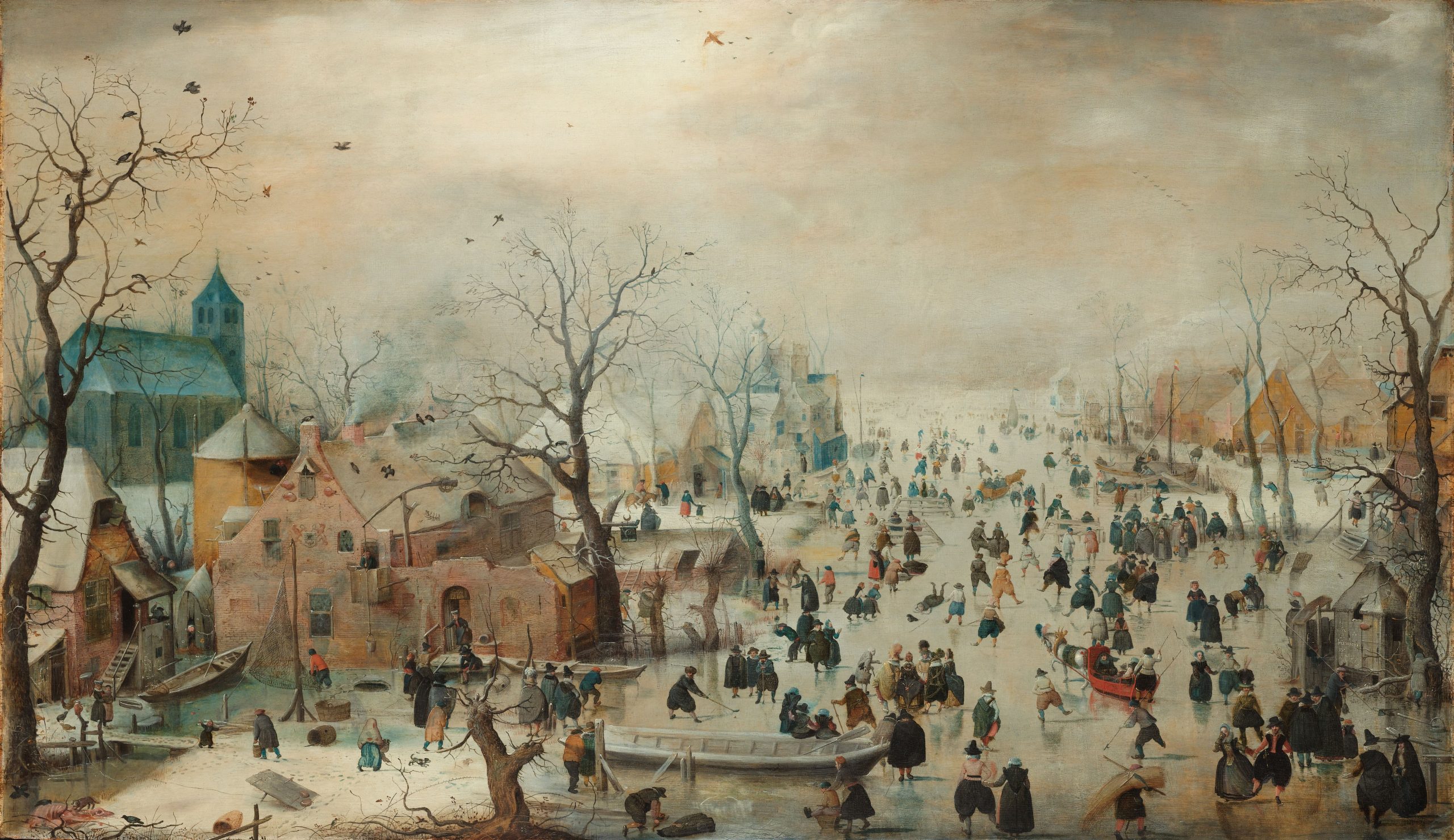
Courtesy: Purchased with the support of the Vereniging Rembrandt. “http://hdl.handle.net/10934/RM0001.COLLECT.5853” is licensed under CC0 1.0.
“In the bleak midwinter” by Christina Rossetti
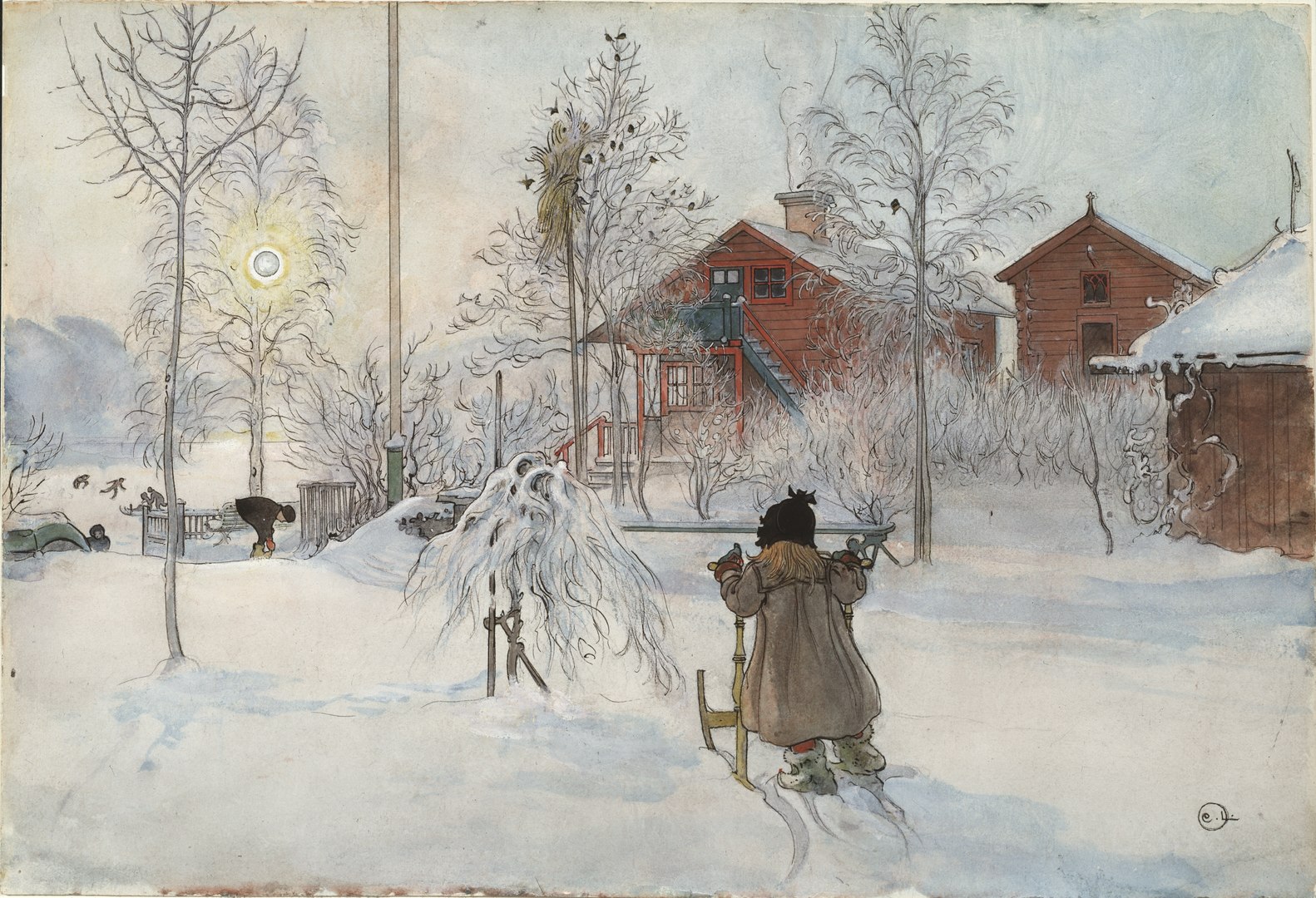
Courtesy: Cecilia Heisser / Nationalmuseum. “https://collection.nationalmuseum.se/eMP/eMuseumPlus?service=ExternalInterface&module=collection&objectId=24217&viewType=detailView” is in the Public Domain.
For more example of Carl Larsson’s art please open the link here.
Polar Bears –Precious and Increasing Endangered
“Discrete populations of polar bears are found throughout ice-covered waters of the circumpolar Arctic. In Canada, there are 13 populations, totaling approximately 15, 000 bears. Polar bears are largely marine animals, preferring to remain on the sea ice where they ethmain prey of seals. They feed primarily on ringed seals although bears will also eat bearded seals and occasionally walruses, beluga whales and narwhals. In many areas of the arctic, they are able to hunt on the ice year-round. It is only in areas where the ice melts in the summer, like southwestern Hudson Bay, that the bears are forced ashore until the ice refreezes in the fall.” (Churchill Science)
Excerpt from A Winter Walk (1843) by Henry David Thoreau (1817-1862)
Walden is an exposure of Thoreau’s philosophy of life. He saw the goal of life to be exploration of personal, spiritual growth, and he proposed to live a simple life and study the Nature so as to attain it. His thoughts and suggestions are both idealistic and practical.
Thoreau’s attitude toward reform involved his transcendental efforts to live a spiritually meaningful life in nature. As a transcendentalist, Thoreau believed that reality existed only in the spiritual world, and the solution to people?s problems was the free development of emotions (?Transcendentalism?).
The wind has gently murmured through the blinds, or puffed with feathery softness against the windows, and occasionally sighed like a summer zephyr lifting the leaves along, the livelong night. The meadow mouse has slept in his snug gallery in the sod, the owl has sat in a hollow tree in the depth of the swamp, the rabbit, the squirrel, and the fox have all been housed. The watch-dog has lain quiet on the hearth, and the cattle have stood silent in their stalls. The earth itself has slept, as it were its first, not its last sleep, save when some street-sign or wood-house door has faintly creaked upon its hinge, cheering forlorn nature at her midnight work,—the only sound awake ‘twixt Venus and Mars,—advertising us of a remote inward warmth, a divine cheer and fellowship, where gods are met together, but where it is very bleak for men to stand. But while the earth has slumbered, all the air has been alive with feathery flakes descending, as if some northern Ceres reigned, showering her silvery grain over all the fields.
[2] We sleep, and at length awake to the still reality of a winter morning. The snow lies warm as cotton or down upon the window-sill; the broadened sash and frosted panes admit a dim and private light, which enhances the snug cheer within. The stillness of the morning is impressive. The floor creaks under our feet as we move toward the window to look abroad through some clear space over the fields. We see the roofs stand under their snow burden. From the eaves and fences hang stalactites of snow, and in the yard stand stalagmites covering some concealed core. The trees and shrubs rear white arms to the sky on every side; and where were walls and fences, we see fantastic forms stretching in frolic gambols across the dusky landscape, as if Nature had strewn her fresh designs over the fields by night as models for man’s art. (Retrieved from American Transcendentalism Web)
“Winter-Time” by Robert Louis Stevenson
Late lies the wintry sun a-bed,
A frosty, fiery sleepy-head;
Blinks but an hour or two; and then,
A blood-red orange, sets again.
Before the stars have left the skies,
At morning in the dark I rise;
And shivering in my nakedness,
By the cold candle, bathe and dress.
Close by the jolly fire I sit
To warm my frozen bones a bit;
Or with a reindeer-sled, explore
The colder countries round the door.
When to go out, my nurse doth wrap
Me in my comforter and cap;
The cold wind burns my face, and blows
Its frosty pepper up my nose.
Black are my steps on silver sod;
Thick blows my frosty breath abroad;
And tree and house, and hill and lake,
Are frosted like a wedding-cake.
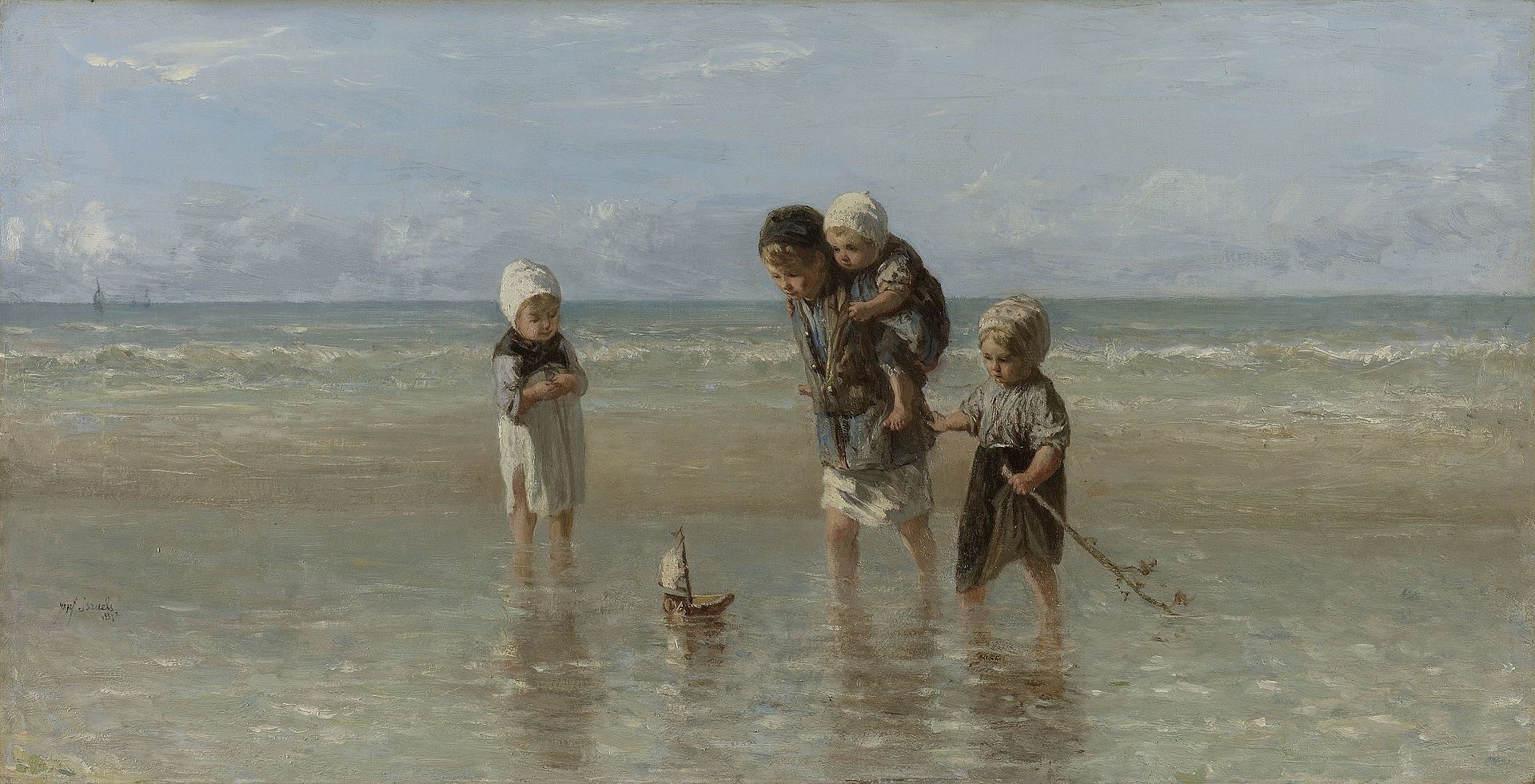
Courtesy: Legate of Mr. J.B.A.M. Westerwoudt, Haarlem. “http://hdl.handle.net/10934/RM0001.COLLECT.8817” is licensed under CC0 1.0.
”The Child’s Faith is New” by Emily Dickinson
The Child’s faith is new—
Whole—like His Principle—
Wide—like the Sunrise
On fresh Eyes—
Never had a Doubt—
Laughs—at a Scruple—
Believes all sham
But Paradise—
Resources:
“Sea-Shore” by Ralph Waldo Emerson
I heard or seemed to hear the chiding Sea
Say, Pilgrim, why so late and slow to come?
Am I not always here, thy summer home?
Is not my voice thy music, morn and eve?
My breath thy healthful climate in the heats,
My touch thy antidote, my bay thy bath?
Was ever building like my terraces?
Was ever couch magnificent as mine?
Lie on the warm rock-ledges, and there learn
A little hut suffices like a town.
I make your sculptured architecture vain,
Vain beside mine. I drive my wedges home,
And carve the coastwise mountain into caves.
Lo! here is Rome, and Nineveh, and Thebes,
Karnak, and Pyramid, and Giant’s Stairs,
Half piled or prostrate; and my newest slab
Older than all thy race.
Behold the Sea,
The opaline, the plentiful and strong,
Yet beautiful as is the rose in June,
Fresh as the trickling rainbow of July;
Sea full of food, the nourisher of kinds,
Purger of earth, and medicine of men;
Creating a sweet climate by my breath,
Washing out harms and griefs from memory,
And, in my mathematic ebb and flow,
Giving a hint of that which changes not.
Rich are the sea-gods:–who gives gifts but they?
They grope the sea for pearls, but more than pearls:
They pluck Force thence, and give it to the wise.
For every wave is wealth to Daedalus,
Wealth to the cunning artist who can work
This matchless strength. Where shall he find, O waves!
A load your Atlas shoulders cannot lift?
For the complete poem please open the link here.
“The Trees in the Garden Rained Flowers” by Stephen Crane
The trees in the garden rained flowers.
Children ran there joyously.
They gathered the flowers
Each to himself.
Now there were some
Who gathered heaps—
Having opportunity and skill—
Until, behold, only chance blossoms
Remained for the feeble.
Then a little spindling tutor
Ran importantly to her father, crying:
“Pray, come hither!”
See this unjust thing in your garden!”
But when the father had surveyed,
He admonished the tutor:
“Not so, small sage!
This thing is just.
For look you,
Are not they who possess the flowers
Stronger, bolder, shrewder
Than they who have none?
Why should the strong—
The beautiful strong—
Why should not they have the flowers?”
Upon reflection, the tutor bowed to the ground,
“My lord,” he said,
“The stars are displaced
By this towering wisdom.”
From: Gwynn, R.S. Poetry: A Pocket Anthology (Sixth Edition) (pp. 191-192). Penguin Academics/Pearson Education 2009.
“Consider the lilies how they grow: they toil not, they spin not; and yet I say unto you, that Solomon in all his glory was not arrayed like one of these “(Luke 12:27-28,Matthew 6:28-30King James Version, The Bible.
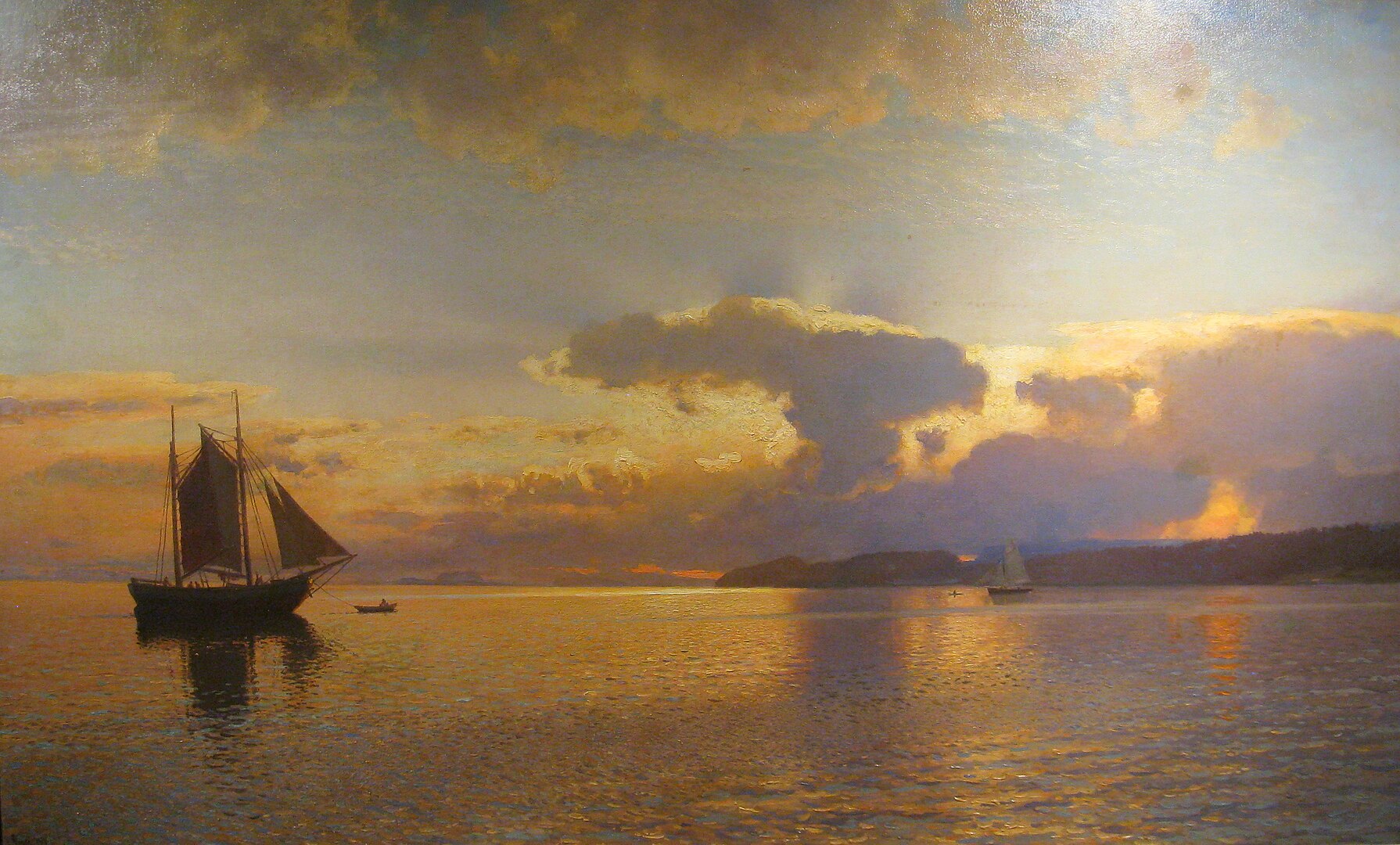
Courtesy: By Hans Gude – Painted by Hans Gude (1825-1903); I took this photograph., Public Domain, https://commons.wikimedia.org/w/index.php?curid=97034197
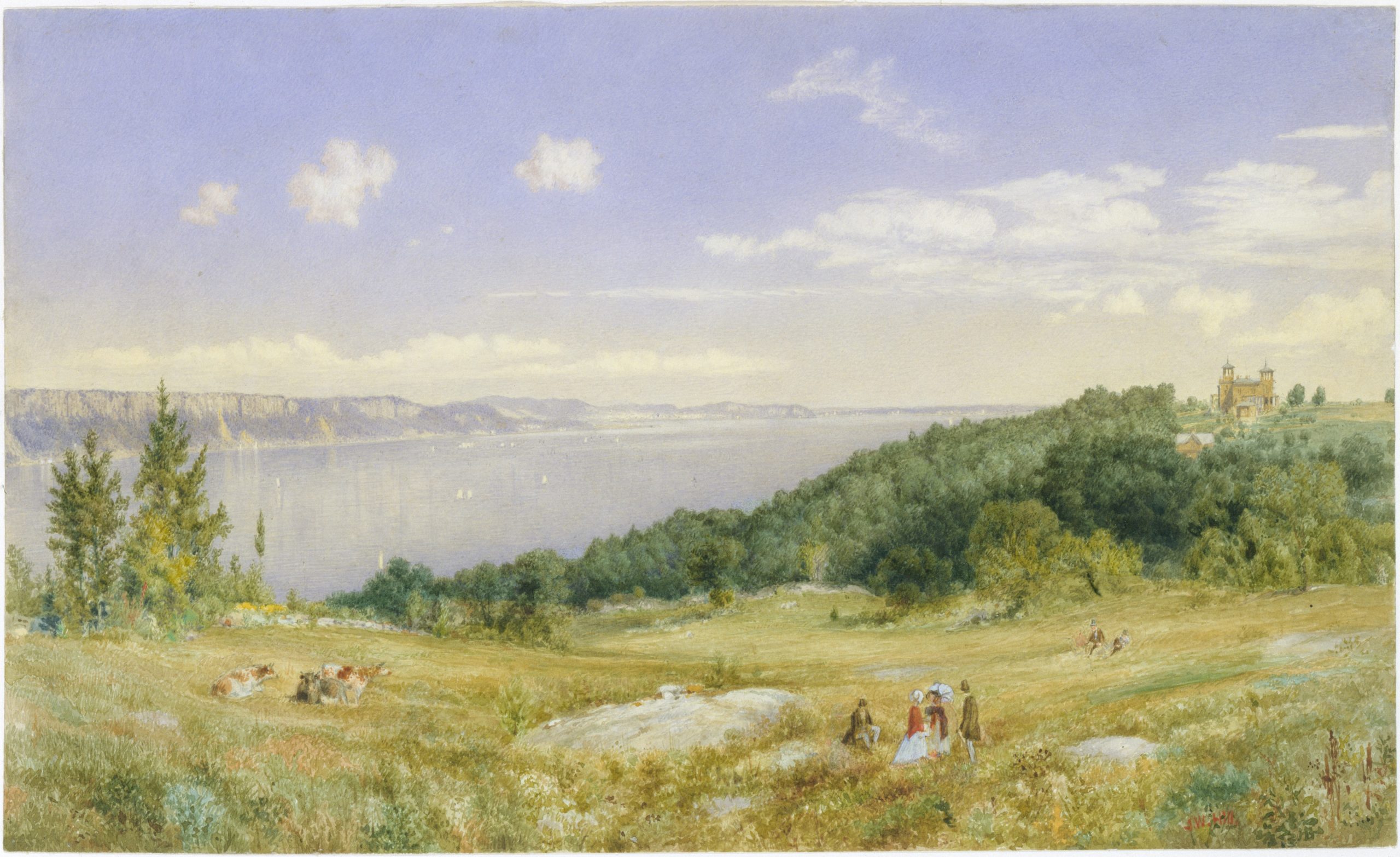
Courtesy: Morris K. Jesup Fund, 1993. “https://www.metmuseum.org/art/collection/search/12953” is licensed under CC0 1.0.
Teaching about Landscapes and Literature: The Getty Centre, Los Angeles, California.
“To Spring” by William Blake
O thou with dewy locks, who lookest down
Thro’ the clear windows of the morning, turn
Thine angel eyes upon our western isle,
Which in full choir hails thy approach, O Spring!
The hills tell each other, and the listening
Valleys hear; all our longing eyes are turned
Up to thy bright pavilions: issue forth,
And let thy holy feet visit our clime.
Come o’er the eastern hills, and let our winds
Kiss thy perfumed garments; let us taste
Thy morn and evening breath; scatter thy pearls
Upon our love-sick land that mourns for thee.
O deck her forth with thy fair fingers; pour
Thy soft kisses on her bosom; and put
Thy golden crown upon her languished head,
Whose modest tresses were bound up for thee.
“To Summer” by William Blake
O thou who passest thro’ our valleys in
Thy strength, curb thy fierce steeds, allay the heat
That flames from their large nostrils! thou, O Summer,
Oft pitched’st here thy goldent tent, and oft
Beneath our oaks hast slept, while we beheld
With joy thy ruddy limbs and flourishing hair.
Beneath our thickest shades we oft have heard
Thy voice, when noon upon his fervid car
Rode o’er the deep of heaven; beside our springs
Sit down, and in our mossy valleys, on
Some bank beside a river clear, throw thy
Silk draperies off, and rush into the stream:
Our valleys love the Summer in his pride.
Our bards are fam’d who strike the silver wire:
Our youth are bolder than the southern swains:
Our maidens fairer in the sprightly dance:
We lack not songs, nor instruments of joy,
Nor echoes sweet, nor waters clear as heaven,
Nor laurel wreaths against the sultry heat.
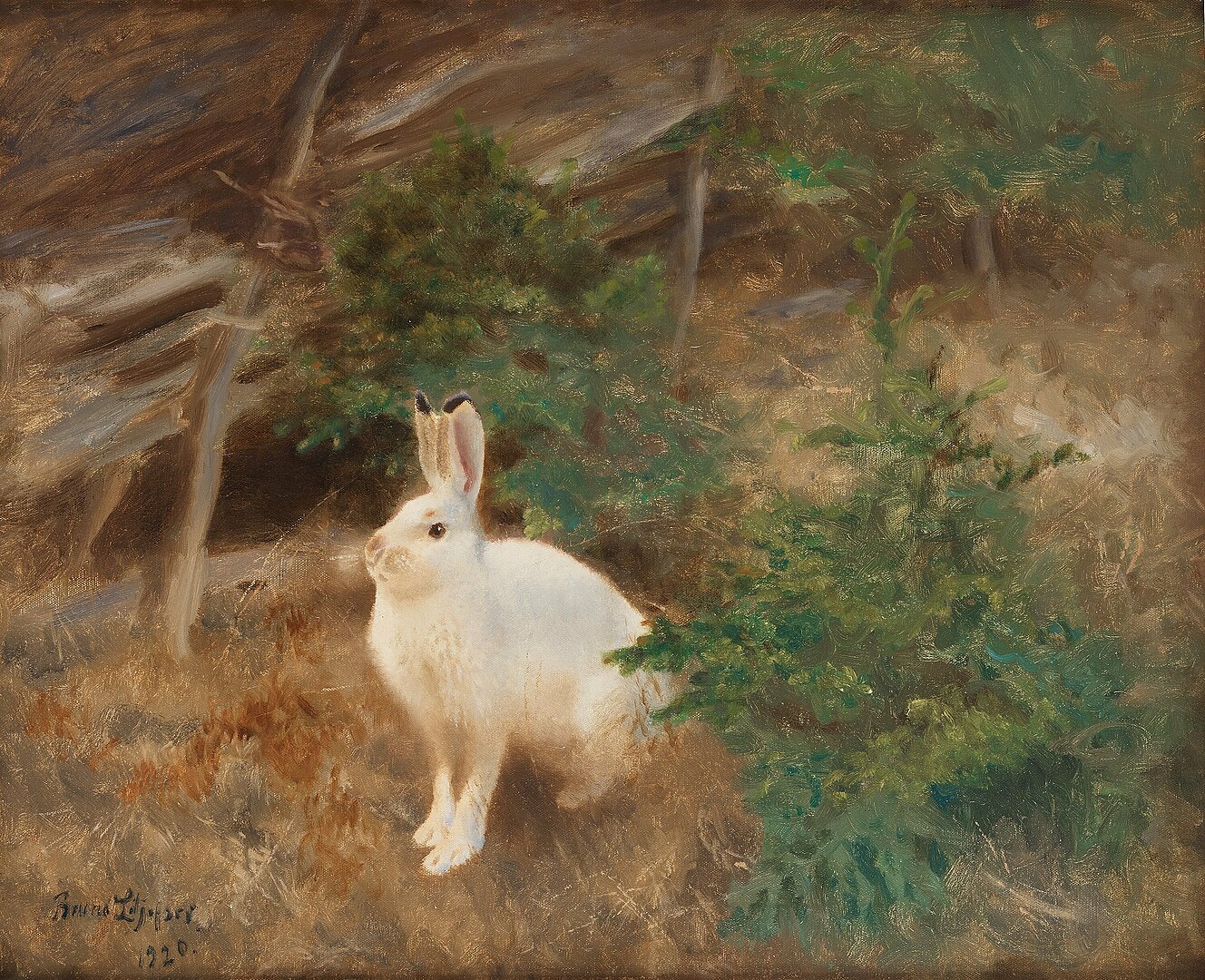
Courtesy: By Bruno Liljefors – Bukowskis, Public Domain, https://commons.wikimedia.org/w/index.php?curid=110892337
“The Orange Tree” by John Shaw Neilson
The young girl stood beside me.
I Saw not what her young eyes could see:
– A light, she said, not of the sky
Lives somewhere in the Orange Tree.
– Is it, I said, of east or west?
The heartbeat of a luminous boy
Who with his faltering flute confessed
Only the edges of his joy?
Was he, I said, borne to the blue
In a mad escapade of Spring
Ere he could make a fond adieu
To his love in the blossoming?
– Listen! the young girl said. There calls
No voice, no music beats on me;
But it is almost sound: it falls
This evening on the Orange Tree…..
For the complete poem please open the link here.
Retrieved November 20, 2022. Internet Archive. Collected Poems of John Shaw Nielsen.
John Shaw Neilson (editor: R. H. Croll), Collected Poems of John Shaw Neilson, Melbourne: Lothian Publishing Company, 1934 [May 1949 reprint], pages 100-101
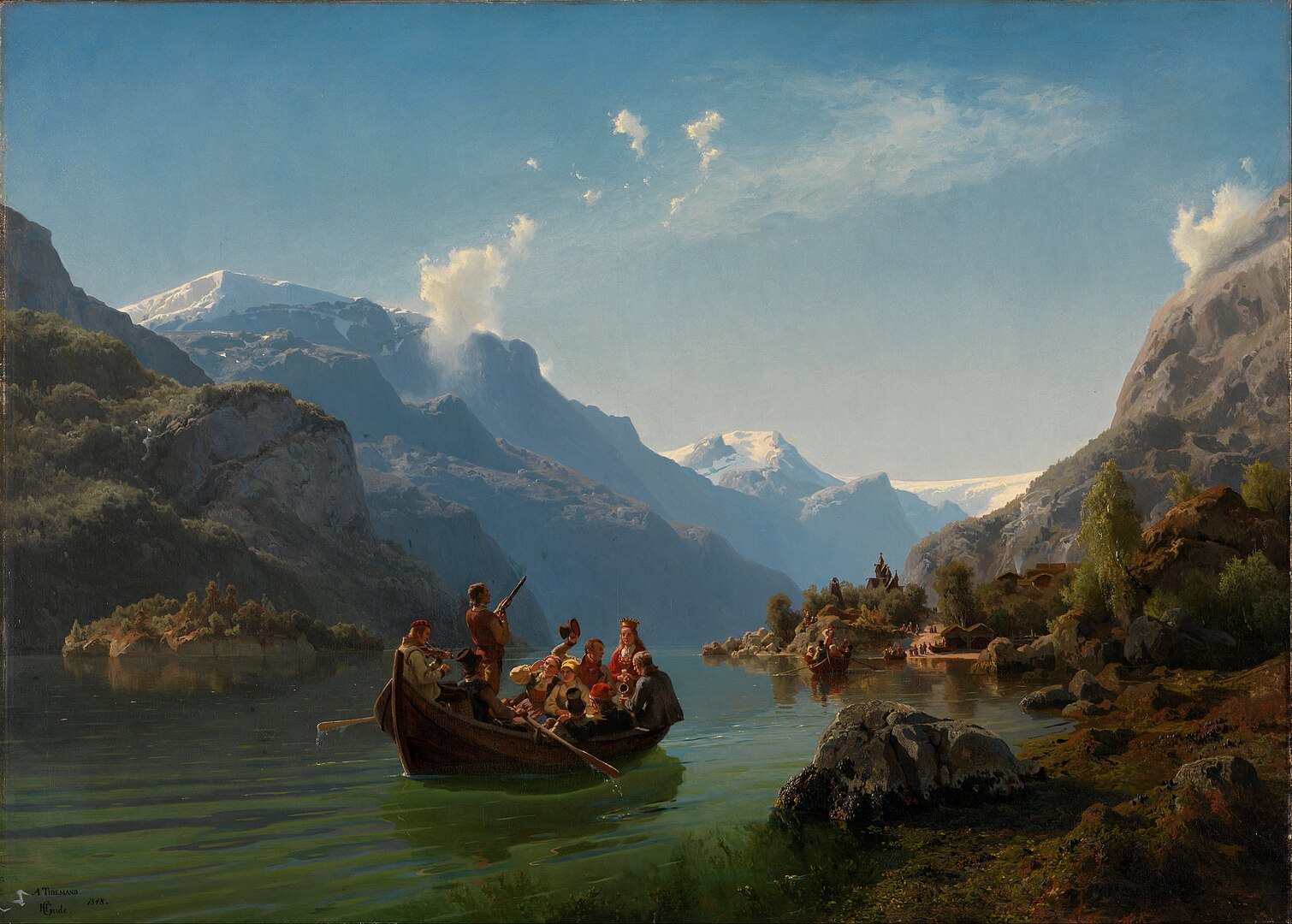
Courtesy: Nasjonalmuseet for kunst, arkitektur og design, The Fine Art Collections. Photo by Børre Høstland. “https://www.nasjonalmuseet.no/en/collection/object/NG.M.00467” is licensed under CC-BY 4.0.
“Sonnet: Oh! How I Love, on a Fair Summer’s Eve” by John Keats
Oh! how I love, on a fair summer’s eve,
When streams of light pour down the golden west,
And on the balmy zephyrs tranquil rest
The silver clouds, far — far away to leave
All meaner thoughts, and take a sweet reprieve
From little cares; to find, with easy quest,
A fragrant wild, with Nature’s beauty drest,
And there into delight my soul deceive.
There warm my breast with patriotic lore,
Musing on Milton’s fate — on Sydney’s bier —
Till their stern forms before my mind arise:
Perhaps on wing of Poesy upsoar,
Full often dropping a delicious tear,
When some melodious sorrow spells mine eyes
“Autumn” by Rainer Maria Rilke
The leaves fall, fall as from far,
Like distant gardens withered in the heavens;
They fall with slow and lingering descent.
And in the nights the heavy Earth, too, falls
From out the stars into the Solitude.
Thus all doth fall. This hand of mine must fall
And lo! the other one:—it is the law.
But there is One who holds this falling
Infinitely softly in His hands.
“The Angels” by Rainer Maria Rilke
They all have tired mouths
And luminous, illimitable souls;
And a longing (as if for sin)
Trembles at times through their dreams.
They all resemble one another,
In God’s garden they are silent
Like many, many intervals
In His mighty melody.
But when they spread their wings
They awaken the winds
That stir as though God
With His far-reaching master hands
Turned the pages of the dark book of Beginning.
“Autumnal Day” by Rainer Maria Rilke
Lord! It is time. So great was Summer’s glow:
Thy shadows lay upon the dials’ faces
And o’er wide spaces let thy tempests blow.
Command to ripen the last fruits of thine,
Give to them two more burning days and press
The last sweetness into the heavy wine.
He who has now no house will ne’er build one,
Who is alone will now remain alone;
He will awake, will read, will letters write
Through the long day and in the lonely night;
And restless, solitary, he will rove
Where the leaves rustle, wind-blown, in the grove.
“Autumn” by Bliss Carman
Now when the time of fruit and grain is come
When apples hang above the orchard wall,
And from the tangle by the roadside stream
A scent of wild grapes fills the racy air,
Comes Autumn with her sunburnt caravan,
Like a long gypsy train with trappings gay
And tattered colors of the Orient,
Moving slow-footed through the dreamy hills.
The woods of Wilton at her coming wear
Tints of Bokhara and of Samarcand;/
The maples glow with their Pompeian red,
The hickories with burnt Etruscan gold;
And while the crickets fife along her march,
Behind her banners burns the crimson sun.
For more information about the Canadian poet Bliss Carman please open the link here.
“Solitude” by Maria Rainer Rilke
Solitude is like a rain
That from the sea at dusk begins to rise;
It floats remote across the far-off plain
Upward into its dwelling-place, the skies,
Then o’er the town it slowly sinks again.
Like rain it softly falls at that dim hour
When ghostly lanes turn toward the shadowy morn;
When bodies weighed with satiate passion’s power
Sad, disappointed from each other turn;
When men with quiet hatred burning deep
Together in a common bed must sleep—
Through the gray, phantom shadows of the dawn
Lo! Solitude floats down the river wan …

Courtesy: By Alfred Stevens – igEYBdSyh-lm1g at Google Cultural Institute maximum zoom level, Public Domain, https://commons.wikimedia.org/w/index.php?curid=22493218
“To Autumn” by John Keats
Season of mists and mellow fruitfulness,
Close bosom-friend of the maturing sun;
Conspiring with him how to load and bless
With fruit the vines that round the thatch-eves run;
To bend with apples the moss’d cottage-trees,
And fill all fruit with ripeness to the core;
To swell the gourd, and plump the hazel shells
With a sweet kernel; to set budding more,
And still more, later flowers for the bees,
Until they think warm days will never cease,
For summer has o’er-brimm’d their clammy cells……(p. 242)
For the complete poem, please open the link here.
Excerpt from “Ode to the West Wind” by Percy Bysshe Shelley
“Apple-Blossom“ by Mathilde Blind
Blossom of the apple trees!
Mossy trunks all gnarled and hoary,
Grey boughs tipped with rose-veined glory,
Clustered petals soft as fleece
Garlanding old apple trees!
How you gleam at break of day!
When the coy sun, glancing rarely,
Pouts and sparkles in the pearly
Pendulous dewdrops, twinkling gay
On each dancing leaf and spray.
Through your latticed boughs on high,
Framed in rosy wreaths, one catches
Brief kaleidoscopic snatches
Of deep lapis-lazuli
In the April-coloured sky.
When the sundown’s dying brand
Leaves your beauty to the tender
Magic spells of moonlight splendour,
Glimmering clouds of bloom you stand,
Turning earth to fairyland.
Cease, wild winds, O, cease to blow!
Apple-blossom, fluttering, flying,
Palely on the green turf lying,
Vanishing like winter snow;
Swift as joy to come and go.
For more poetry by Mathilde Blind please open the Internet Archive link here.
Winter Scenes

Courtesy: By Emanuel Petersen – bruun-rasmussen.dk, Public Domain, https://commons.wikimedia.org/w/index.php?curid=113217581
“The polar bear (Ursus maritimus) is the largest living species of bear. They are found throughout the circumpolar Arctic. In Canada, this means polar bears live in parts of the Yukon, the Northwest Territories, Nunavut, Manitoba,Ontario, Quebec and Newfoundland and Labrador. Polar bears are both culturally and economically significant to the Inuit. As climate change continues to reduce their sea ice habitat, polar bears are increasingly threatened.” (Retrieved November 9, 2022. Canadian Encyclopedia)
Polar Bears –Precious and Increasing Endangered
“Discrete populations of polar bears are found throughout ice-covered waters of the circumpolar Arctic. In Canada, there are 13 populations, totaling approximately 15, 000 bears. Polar bears are largely marine animals, preferring to remain on the sea ice where they ethmain prey of seals. They feed primarily on ringed seals although bears will also eat bearded seals and occasionally walruses, beluga whales and narwhals. In many areas of the arctic, they are able to hunt on the ice year-round. It is only in areas where the ice melts in the summer, like southwestern Hudson Bay, that the bears are forced ashore until the ice refreezes in the fall.” Retrieved November 9, 2022. Churchill Science)
- For more information about the Polar Bears of Churchill, Manitoba, please open the link here.
- For information about the Canadian artist and activist Kal Barteski please open the link here.
- Internet Archive: The Fine Arts in Canada. Water Colour of Polar Bear and Norther Lights by H.R. Millar (p. 57). MacMillan Company of Canada at St. Martin’s House, 1925.
“The Harsh Country” by Theodore Roethke
There was a hardness of stone,
An uncertain glory,
Glitter of basalt and mica,
And the sheen of ravens.
Between cliffs of light
We strayed like children
Not feeling the coarse shale
That cut like razors,
For a blond hill beckoned
Like an enormous beacon,
Shifting in sea change
Not ever farther.
Yet for this we travelled
With hope, and not alone,
In the country of ourselves
In a country of bright stone.
“No Bird” by Theodore Roethke
Now here is peace for one who knew
The secret heart of sound.
The ear so delicate and true
Is pressed to noiseless ground.
Slow swings the breeze above her head,
The grasses whitely stir;
But in this forest of the dead
No bird awakens her.
“The Snow-Storm” by Ralph Waldo Emerson
Announced by all the trumpets of the sky,
Arrives the snow, and, driving o’er the fields,
Seems nowhere to alight: the whited air
Hides hills and woods, the river, and the heaven,
And veils the farm-house at the garden’s end.
The sled and traveller stopped, the courier’s feet
Delayed, all friends shut out, the housemates sit
Around the radiant fireplace, enclosed
In a tumultuous privacy of storm.
Come see the north wind’s masonry.
Out of an unseen quarry evermore
Furnished with tile, the fierce artificer
Curves his white bastions with projected roof
Round every windward stake, or tree, or door.
Speeding, the myriad-handed, his wild work
So fanciful, so savage, nought cares he
For number or proportion. Mockingly,
On coop or kennel he hangs Parian wreaths;
A swan-like form invests the hidden thorn;
Fills up the farmer’s lane from wall to wall,
Maugre the farmer’s sighs; and, at the gate,
A tapering turret overtops the work.
And when his hours are numbered, and the world
Is all his own, retiring, as he were not,
Leaves, when the sun appears, astonished Art
To mimic in slow structures, stone by stone,
Built in an age, the mad wind’s night-work,
The frolic architecture of the snow.
Books Inspired by Nature
Adamson, J.(1960). Born Free. Harper Collins.
Baione, T. (2012). Natural histories: Extraordinary rare book selections from the American Museum of Natural History. Sterling Signature.
Beresford -Kroeger, D. The global forest. Penguin Random House Canada.
Finkler, W., & Davis, S. The science of hope: Eye to eye with our world’s wildlife. Exisle Publishing.
Haeckel, E. (2012). Art forms in nature. Prestel.
Hayhoe, K. (2021) Saving Us : A Climate Scientist’s Case for Hope and Healing in a Divided World.
Simon and Schuster.
Hayhoe, K. (2021) Saving Us : A Climate Scientist’s Case for Hope and Healing in a Divided World. Simon and Schuster.
Katherine Hayhoe(2018). Ted Talk on climate change, hope, and healing (“The most important thing you can do about climate change is talk about it.”)
Gater, W. (2020).
Gibson, G. (2006). The bedside book of birds. Penguin Random House.
Gibson, G. (2009). The bedside book of beasts: A wildlife miscellany. Doubleday Canada.
MacFarlane, R. Landmarks. Penguin Books.
Norbury, K. (2017). Review of The Lost Words. The Guardian.
Maybe, R. (2015). The cabaret of plants: Forty thousand years of plant life and the human imagination. W.W. Norton.
Myers, N.R., Pastoureau, M., Taburet-Delahaye, E., & Zink, M. (2016). Art and nature in the middle ages. Dallas Museum of Art.
Thoreau, H.D. (1854). Walden or A life in the woods. Project Gutenberg, 1995, https://www.gutenberg.org/files/205/205-h/205-h.htm
Wohlleben, P. The hidden life of trees: The illustrated edition. Greystone Books.
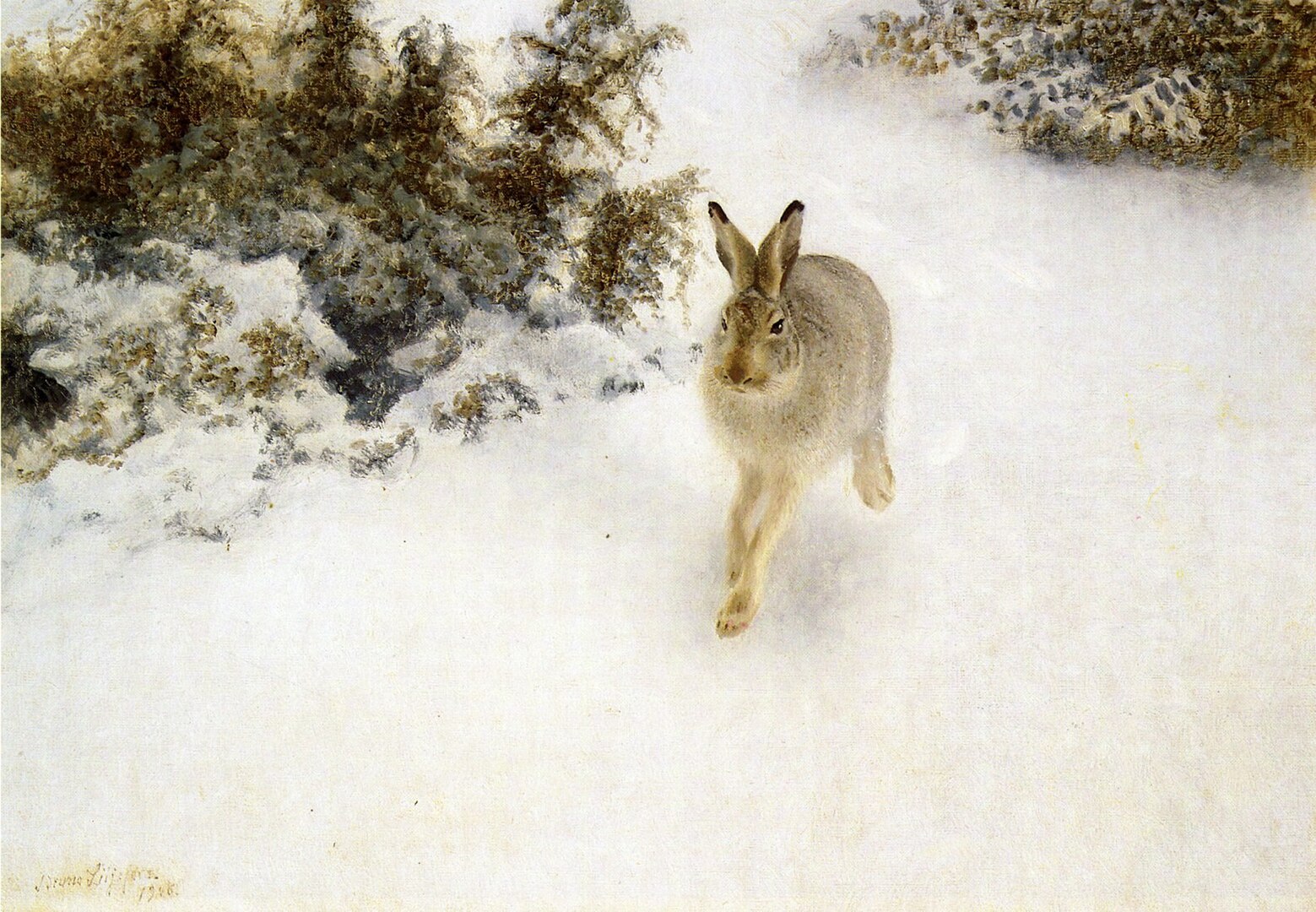
Courtesy: By Bruno Liljefors – Scan from Bruno Liljefors – The Peerless Eye, ISBN 0-948493-04-6, Public Domain, https://commons.wikimedia.org/w/index.php?curid=7268442

